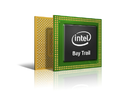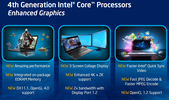Intel HD Graphics (Bay Trail) vs Intel HD Graphics 2000 vs Intel HD Graphics 4400
Intel HD Graphics (Bay Trail) ► remove from comparison
Die Intel HD Graphics (Bay Trail) ist eine in den Tablet- (z.B. Z3770 ), Nettop- (z.B. J2850 ) und Notebook-SoCs (z.B. N3510 ) der Bay-Trail-Serie integrierte Grafikeinheit. Sie ist in verschiedenen Atom-, Celeron- und Pentium-Modellen zu finden und basiert auf der DirectX-11-tauglichen GPU der Ivy-Bridge-Generation . Taktrate und Einheitenzahl fallen allerdings deutlich niedriger aus, sodass sich die Performance nur im Low-End-Segment ansiedelt.
Im Vergleich zu Ivy Bridge, dessen Gen-7-GPU entweder 6 oder 16 Executions Units bietet, kommt die HD Graphics (Bay Trail) nur mit lediglich 4 EUs daher. Abhängig von Temperatur und Leistungsaufnahme kann die niedrige Basisfrequenz dynamisch bis auf den maximalen Turbo-Takt angehoben werden, der ja nach Modell bei bis zu 896 MHz liegt. Ebenfalls modellabhängig ist das Speicherinterface, welches im Single- oder Dual-Channel-Betrieb sowie mit verschiedene Speicherstandards (DDR3(L), DDR3L-RS, LPDDR3) arbeiten kann. Insbesondere Varianten mit einem nur 32 Bit breiten Interface (Atom Z3735G ) verlieren teils erheblich an Performance.
Die schnellsten Notebook-Modelle erreichen knapp die Performance der HD Graphics (Sandy Bridge) sowie der Radeon HD 6310 . Das reicht, um einige ältere und sehr anspruchslose Windows-Spiele wie World of Warcraft oder Half-Life 2 in niedrigen Einstellungen flüssig darzustellen. Für aktuelle Windows-Titel ist die GPU dagegen praktisch nicht geeignet.
Verglichen mit konkurrierenden ARM-SoCs ordnet sich die Grafikeinheit dagegen im unteren High-End-Segment ein und übertrifft knapp die Adreno 320 , die in verschiedenen Qualcomm-SoCs wie dem Snapdragon 600 zu finden ist. Damit entspricht Grafik-Performance in etwa Nvidias Tegra 4 . Auch sehr aufwändige Android-Spiele werden damit in hohen Auflösungen flüssig bewältigt (Stand 2013).
Der integrierte Videodecoder unterstützt alle gängigen Codecs wie MPEG2, H.264, VC1, MVC oder VP8 und ist für Auflösungen bis 4K (maximal 100 Mbit/s) geeignet. Das Bildsignal kann per HDMI 1.4 (max. 1.920 x 1.080) oder DisplayPort 1.2 (max. 2.560 x 1.600) an bis zu zwei Displays ausgegeben werden. Eine weitere Neuerung ist die Unterstützung von Wireless Display sowie Quick Sync , Intels schnellem und sparsamen H-264-Hardwareencoder. Einige dieser Features sind jedoch nicht bei allen Modellen verfügbar.
Je nach Modell liegt die Leistungsaufnahme des gesamten SoCs zwischen rund 2 und 10 Watt. Die besonders sparsamen Versionen sind damit auch für passiv gekühlte Tablets geeignet, andere werden in größeren (Sub-) Notebooks mit aktiver Kühlung eingesetzt.
Intel HD Graphics 2000 ► remove from comparison
Die Intel HD Graphics 2000 (oder Intel Graphics Media Accelerator HD 2000 oder GMA HD 2000) ist eine in den Sandy Bridge Prozessoren integrierte Grafikkarte. Sie komm in den meisten Desktop CPU zum Einsatz und heisst in den günstigen mobilen Prozessoren (Celeron und Pentium) nur Intel HD Graphics . Die HD Graphics 2000 bietet keinen eigenen dedizierten Speicher, teilt sich jedoch den sehr schnellen Level 3 Cache mit den Prozessorkernen. Der restliche Speicher wird vom Hauptspeicher abgezwackt (wie bei der Vorgänger-Grafikkarte Intel HD Graphics ). Dank Turbo Boost kann sich die Grafikkarte wie die Prozessorkerne in gewissen Lastsituationen übertakten (bei ausreichend Kühlung). Die Intel GMA HD2000 bietet nur die Hälfte der 12 Execution Units (EUs) der GMA HD 3000 und ist dadurch deutlich langsamer.
Je nach Prozessor weist die HD Graphics 2000 eine unterschiedliche Basis- und Turbo-Taktrate auf. Im Desktop Einsteigs Core i3-2100 z.B. 850 bzw 1100 MHz. Im schnellen i7-2600 850 bzw. 1350MHz. Die mobilen Ableger werden wahrscheinlich deutlich geringer getaktet sein.
Unsere Performance Tests haben wir mit einem i5-2400 Desktop Prozessor durchgeführt. Dieser taktet die Grafikkarte mit 850MHz bzw 1100MHz (Turbo Boost). In den Spieletests plazierte sich die HD Graphics 2000 etwa auf dem Niveau einer Geforce G 105M und damit leicht oberhalb der alten Intel HD Graphics Grafikkarte. Damit sind anspruchslose Spiele wie Sims 3 oder World of Warcraft in niedrigen Details flüssig spielbar (mit einer ausreichend starken CPU).
Wie bei den Ivy Bridge basierten Grafikkarten, wird anscheinend auch bei Sandy Bridge 2x Antialiasing per Software aus dem 4x Antialiasing errechnet. Daher ergibt sich kein Geschwindigkeitsunterschied zwischen 2x und 4x AA. Im Unigine Valley Benchmark erreichten wir als Bestätigung bei 2x AA und 4x AA das selbe Ergebnis (HD Graphics 3000 ULV im i7-2637M).
Neben der GPU ist auch noch eine dedizierte Einheit zum Dekodieren und auch Encodieren von HD Videos in den Sandy Bridge Prozessoren enthalten. Um ein dreiminütiges 1080p-Video für das iPhone in das Format 640x360 zu wandeln, braucht Sandy Bridge laut Intel etwa 14s (IDF 2010). Eine weitere Besonderheit ist der unterstützte "embedded DisplayPort" eDP um interne Displays anzusteuern.
Aufgrund der Integration in den mit 32nm gefertigten Prozessor und die halbierte Shaderzahl, ist der Stromverbrauch relativ gering und eignet sich auch für flache und kleine Notebooks.
Intel HD Graphics 4400 ► remove from comparison
Die Intel HD Graphics 4400 (GT2) ist eine Prozessorgrafikkarte in einigen ULV-CPUs der Haswell Generation. Je nach Prozessormodell wird die Intel HD Graphics 4400 unterschiedlich getaktet und kann auf einen unterschiedlich großen Cache zurückgreifen. All dies sowie die Geschwindigkeit des angebundenen Arbeitsspeichers beeinflusst die Performance entscheidend. Im Vergleich zur HD 4600 bietet die HD 4400 gleich viele Shaderkerne, aber geringere Taktraten (siehe Taktratenliste der Modelle weiter unten).
Der Grafikkern wurde im Vergleich zum Intel HD Graphics 4000 der Ivy-Bridge-Generation in verschiedenen Punkten weiterentwickelt. So unterstützt die GPU nun mit DirectX 11.1, OpenCL 1.2 und OpenGL 4.0 alle wichtigen aktuellen Standards. Auch ein verbesserter Decoder für 4K-Videos sowie ein überarbeiteter Quick-Sync-Encoder sind mit an Bord.
Die Performance der HD Graphics 4400 liegt deutlich unter der HD 4600 , da die GPU in ULV-Modellen mit relativ geringer Taktrate eingesetzt wird. Desweiteren limitiert die niedrige TDP dieser Modelle den Turbo Boost, der oftmals nicht vollständig ausgeschöpft werden kann. Gegenüber der HD 4000 in den ULV-Modellen der Ivy-Bridge-Generation ist dennoch ein leichtes Leistungsplus zu verzeichnen. Neben architektonischen Verbesserungen ist dies vor allem auf eine gesteigerte Zahl an Ausführungseinheiten zurückzuführen: Die GT2-Ausbaustufe verfügt nun über 20 der sogenannten EUs (HD 4000: 16). Abhängig von der Taktrate erreicht die HD 4400 in etwa die Leistung einer dedizierten Radeon HD 7550M .
Der Stromverbrauch ist dank des 22-Nanometer-Prozesses mit Tri-Gate-Transistoren relativ gering und wird dynamisch vom TDP-Budget des gesamten Chips abgezweigt. Die HD 4400 kommt in einigen Dual-Core ULV-Prozessoren der 15-Watt-Klasse zum Einsatz.
Weitere Details zur Grafikkartenarchitektur der Haswell Generation, finden Sie in unserem Artikel von der IDF 2012 .
Intel HD Graphics (Bay Trail) Intel HD Graphics 2000 Intel HD Graphics 4400 HD Graphics Serie Codename Bay Trail Sandy Bridge Haswell GT2 Architektur Gen. 7 Ivy Bridge Gen. 6 Sandy Bridge Gen. 7.5 Haswell Pipelines 4 - unified 6 - unified 20 - unified Kerntakt 311 - 896 (Boost) MHz 850/1100 - 1350 (Boost) MHz 200 - 1100 (Boost) MHz Speicherbandbreite 32/64/128 Bit 64/128 Bit 64/128 Bit Shared Memory ja ja ja API DirectX 11, Shader 5.0, OpenGL 4.0, ES 3.0 DirectX 10.1, Shader 4.1 DirectX 11.1, Shader 5.0, OpenGL 4.0 Herstellungsprozess 22 nm 32 nm 22 nm Erscheinungsdatum 11.09.2013 01.02.2011 05.06.2013 Features QuickSync
CPU in HD Graphics (Bay Trail) GPU Base Speed GPU Boost / Turbo Intel Pentium N3540 4 x 2160 MHz, 7.5 W 313 MHz 896 MHz Intel Pentium J2900 4 x 2410 MHz, 10 W 688 MHz 896 MHz Intel Pentium N3530 4 x 2160 MHz, 7.5 W 313 MHz 896 MHz » show 43 more Intel Pentium J2850 4 x 2400 MHz, 10 W 688 MHz 792 MHz Intel Pentium N3520 4 x 2167 MHz, 7.5 W 313 MHz 854 MHz Intel Celeron J1900 4 x 2000 MHz, 10 W 688 MHz 854 MHz Intel Atom Z3795 4 x 1590 MHz, <4 W 311 MHz 778 MHz Intel Atom Z3785 4 x 1490 MHz, <4 W 313 MHz 833 MHz Intel Atom Z3775 4 x 1460 MHz, <4 W 311 MHz 778 MHz Intel Atom Z3775D 4 x 1490 MHz, <4 W 311 MHz 792 MHz Intel Atom Z3770 4 x 1460 MHz, <4 W 311 MHz 667 MHz Intel Atom Z3770D 4 x 1500 MHz, 4 W 313 MHz 688 MHz Intel Celeron N2940 4 x 1830 MHz, 7.5 W 313 MHz 854 MHz Intel Celeron N2930 4 x 1830 MHz, 7.5 W 313 MHz 854 MHz Intel Celeron J1850 4 x 2000 MHz, 10 W 688 MHz 792 MHz Intel Pentium N3510 4 x 2000 MHz, 7.5 W 313 MHz 750 MHz Intel Celeron N2920 4 x 1860 MHz, 7.5 W 313 MHz 854 MHz Intel Atom E3845 4 x 1910 MHz, 10 W 542 MHz 792 MHz Intel Atom Z3736F 4 x 1330 MHz, 4 W 313 MHz 646 MHz Intel Atom Z3736G 4 x 1330 MHz, <4 W 313 MHz 646 MHz Intel Atom Z3745 4 x 1330 MHz, <4 W 311 MHz 778 MHz Intel Atom Z3745D 4 x 1330 MHz, <4 W 311 MHz 792 MHz Intel Atom Z3740 4 x 1330 MHz, <4 W 311 MHz 667 MHz Intel Atom Z3740D 4 x 1330 MHz, <4 W 313 MHz 688 MHz Intel Atom Z3735D 4 x 1330 MHz, <4 W 311 MHz 646 MHz Intel Atom Z3735E 4 x 1330 MHz, <4 W 311 MHz 646 MHz Intel Atom Z3735F 4 x 1330 MHz, <4 W 311 MHz 646 MHz Intel Atom Z3735G 4 x 1330 MHz, <4 W 311 MHz 646 MHz Intel Celeron J1800 2 x 2410 MHz, 10 W 688 MHz 792 MHz Intel Celeron N2840 2 x 2160 MHz, 7.5 W 313 MHz 792 MHz Intel Celeron J1750 2 x 2410 MHz, 10 W 688 MHz 750 MHz Intel Celeron N2910 4 x 1600 MHz, 7.5 W 313 MHz 756 MHz Intel Celeron N2830 2 x 2160 MHz, 7.5 W 313 MHz 750 MHz Intel Celeron N2820 2 x 2170 MHz, 7.5 W 313 MHz 756 MHz Intel Celeron N2815 2 x 1860 MHz, 7.5 W 313 MHz 756 MHz Intel Celeron N2810 2 x 2000 MHz, 7.5 W 313 MHz 756 MHz Intel Atom Z3680 2 x 1330 MHz, 4 W 311 MHz 667 MHz Intel Atom Z3680D 2 x 1330 MHz, 4 W 313 MHz 688 MHz Intel Celeron N2808 2 x 1580 MHz, 4.3 W 313 MHz 792 MHz Intel Celeron N2807 2 x 1580 MHz, 4.3 W 313 MHz 750 MHz Intel Celeron N2806 2 x 1580 MHz, 4.5 W 313 MHz 756 MHz Intel Atom E3827 2 x 1750 MHz, 8 W 542 MHz 792 MHz Intel Atom E3826 2 x 1460 MHz, 7 W 533 MHz 667 MHz Intel Celeron N2805 2 x 1460 MHz, 4.3 W 313 MHz 667 MHz Intel Atom E3825 2 x 1330 MHz, 6 W ? MHz 533 MHz Intel Atom E3815 1 x 1460 MHz, 5 W ? MHz 400 MHz min. - max. 311 - ? MHz 400 - 896 MHz
CPU in HD Graphics 2000 GPU Base Speed GPU Boost / Turbo Intel Core i5-2400 4 x 3100 MHz, 95 W 850 MHz 1100 MHz
CPU in HD Graphics 4400 GPU Base Speed GPU Boost / Turbo Intel Core i7-4600U 2 x 2100 MHz, 15 W 200 MHz 1100 MHz Intel Core i7-4510U 2 x 2000 MHz, 15 W 200 MHz 1100 MHz Intel Core i7-4500U 2 x 1800 MHz, 15 W 200 MHz 1100 MHz » show 10 more Intel Core i5-4310U 2 x 2000 MHz, 15 W 200 MHz 1100 MHz Intel Core i5-4300U 2 x 1900 MHz, 15 W 200 MHz 1100 MHz Intel Core i5-4210U 2 x 1700 MHz, 15 W 200 MHz 1000 MHz Intel Core i5-4200U 2 x 1600 MHz, 15 W 200 MHz 1000 MHz Intel Core i3-4120U 2 x 2000 MHz, 15 W 200 MHz 1000 MHz Intel Core i3-4030U 2 x 1900 MHz, 15 W 200 MHz 1000 MHz Intel Core i3-4025U 2 x 1900 MHz, 15 W 200 MHz 950 MHz Intel Core i3-4100U 2 x 1800 MHz, 15 W 200 MHz 1000 MHz Intel Core i3-4010U 2 x 1700 MHz, 15 W 200 MHz 1000 MHz Intel Core i3-4005U 2 x 1700 MHz, 15 W 200 MHz 950 MHz min. - max. 200 - ? MHz 400 - 1100 MHz
Benchmarks Performance Rating - 3DMark 11 + Fire Strike + Time Spy - HD Graphics (Bay Trail)
0.1 pt (0%)
Intel HD Graphics (Bay Trail)
...
max:
Performance Rating - 3DMark 11 + Fire Strike + Time Spy - HD Graphics 4400
0.3 pt (1%)
...
...
max:
3DMark - 3DMark Ice Storm Unlimited Graphics
min: 11835 avg: 14513 median: 14748.5 (2%) max: 17613 Points
37082 Points (4%)
3DMark - 3DMark Ice Storm Extreme Graphics
min: 4751 avg: 7342 median: 7498 (1%) max: 9234 Points
min: 19943 avg: 25546 median: 24573 (3%) max: 33095 Points
3DMark - 3DMark Cloud Gate Score
min: 354 avg: 1182 median: 1188 (1%) max: 1703 Points
min: 1733 avg: 3980 median: 3940 (4%) max: 4989 Points
3DMark - 3DMark Cloud Gate Graphics
min: 362 avg: 1230 median: 1228.5 (0%) max: 1670 Points
min: 1946 avg: 5040 median: 4953 (1%) max: 6547 Points
3DMark - 3DMark Fire Strike Standard Score
min: 83 avg: 185 median: 147 (0%) max: 495 Points
min: 352 avg: 543 median: 525 (1%) max: 700 Points
3DMark - 3DMark Fire Strike Standard Graphics
min: 90 avg: 149.1 median: 149 (0%) max: 200 Points
min: 369 avg: 592 median: 569 (1%) max: 778 Points
3DMark - 3DMark Ice Storm Graphics
min: 5056 avg: 15391 median: 16047 (2%) max: 21351 Points
min: 12866 avg: 38629 median: 38886.5 (5%) max: 58126 Points
3DMark 11 - 3DM11 Performance Score
min: 143 avg: 222.6 median: 216 (0%) max: 280 Points
min: 460 avg: 843 median: 828 (1%) max: 1032 Points
3DMark 11 - 3DM11 Performance GPU
min: 122 avg: 192.1 median: 186.5 (0%) max: 237 Points
min: 399 avg: 755 median: 735.5 (1%) max: 962 Points
3DMark Vantage + Intel HD Graphics (Bay Trail) 3DMark Vantage - 3DM Vant. Perf. total
min: 507 avg: 666 median: 637 (0%) max: 846 Points
3DM Vant. Perf. total + Intel HD Graphics 2000 min: 789 avg: 896 median: 895.5 (0%) max: 1002 Points
3DM Vant. Perf. total + Intel HD Graphics 4400
min: 2450 avg: 3559 median: 3583 (1%) max: 4820 Points
3DM Vant. Perf. GPU no PhysX + Intel HD Graphics (Bay Trail) 3DMark Vantage - 3DM Vant. Perf. GPU no PhysX
min: 395 avg: 512 median: 503 (0%) max: 667 Points
3DM Vant. Perf. GPU no PhysX + Intel HD Graphics 2000 min: 626 avg: 695 median: 694.5 (0%) max: 763 Points
3DM Vant. Perf. GPU no PhysX + Intel HD Graphics 4400
min: 2083 avg: 3005 median: 2986.5 (2%) max: 4123 Points
3DMark 2001SE - 3DMark 2001 - Standard
7727 Points (8%)
15201 Points (16%)
20486 Points (21%)
3DMark 03 - 3DMark 03 - Standard
min: 4226 avg: 4997 median: 5220 (3%) max: 5323 Points
min: 6077 avg: 7083 median: 7083 (4%) max: 8089 Points
min: 9129 avg: 12378 median: 13244 (7%) max: 16040 Points
3DMark 05 - 3DMark 05 - Standard
min: 2666 avg: 3195 median: 3331 (4%) max: 3445 Points
min: 4585 avg: 5194 median: 5193.5 (6%) max: 5802 Points
min: 6313 avg: 8674 median: 8802 (10%) max: 10495 Points
3DMark 06 3DMark 06 - Score Unknown Settings + Intel HD Graphics (Bay Trail)
2108 Points (3%)
3DMark 06 - Standard 1280x1024 + Intel HD Graphics (Bay Trail)
min: 814 avg: 1785 median: 1866 (2%) max: 2151 Points
3DMark 06 - Standard 1280x1024 + Intel HD Graphics 2000
min: 1217 avg: 2222 median: 2288 (3%) max: 3162 Points
3DMark 06 - Standard 1280x1024 + Intel HD Graphics 4400
min: 4074 avg: 5110 median: 5164 (7%) max: 6293 Points
3DMark 06 - Standard 1280x800 + Intel HD Graphics (Bay Trail)
2087 Points (3%)
Unigine Heaven 3.0 - Unigine Heaven 3.0 DX 11
3.6 fps (1%)
min: 6.5 avg: 7.7 median: 8.2 (3%) max: 8.4 fps
Unigine Heaven 3.0 - Unigine Heaven 3.0 OpenGL
min: 7 avg: 8.2 median: 8.6 (4%) max: 9.1 fps
Unigine Heaven 2.1 - Heaven 2.1 high
min: 2.4 avg: 2.8 median: 2.8 (1%) max: 3.4 fps
5.3 fps (1%)
min: 7.9 avg: 10.9 median: 10.9 (2%) max: 15.9 fps
SPECviewperf 11 + Intel HD Graphics 4400 SPECviewperf 11 - specvp11 snx-01
min: 1.06 avg: 1.6 median: 1.7 (1%) max: 2.09 fps
specvp11 tcvis-02 + Intel HD Graphics 4400 SPECviewperf 11 - specvp11 tcvis-02
min: 1.47 avg: 2.2 median: 2.2 (1%) max: 2.94 fps
specvp11 sw-02 + Intel HD Graphics 4400 SPECviewperf 11 - specvp11 sw-02
min: 6.04 avg: 9.7 median: 9.6 (7%) max: 12.19 fps
specvp11 proe-05 + Intel HD Graphics 4400 SPECviewperf 11 - specvp11 proe-05
min: 1.39 avg: 1.8 median: 1.9 (2%) max: 2.28 fps
specvp11 maya-03 + Intel HD Graphics 4400 SPECviewperf 11 - specvp11 maya-03
min: 7.81 avg: 12.6 median: 12.2 (9%) max: 16.81 fps
specvp11 lightwave-01 + Intel HD Graphics 4400 SPECviewperf 11 - specvp11 lightwave-01
min: 9.88 avg: 13.6 median: 13.2 (14%) max: 17.4 fps
specvp11 ensight-04 + Intel HD Graphics 4400 SPECviewperf 11 - specvp11 ensight-04
min: 1.29 avg: 1.9 median: 2 (1%) max: 2.47 fps
SPECviewperf 12 + Intel HD Graphics 4400 SPECviewperf 12 - specvp12 sw-03
min: 6.92 avg: 9.3 median: 9.3 (2%) max: 11.62 fps
specvp12 snx-02 + Intel HD Graphics 4400 SPECviewperf 12 - specvp12 snx-02
min: 1.99 avg: 2 median: 2 (0%) max: 2.08 fps
specvp12 showcase-01 + Intel HD Graphics 4400 SPECviewperf 12 - specvp12 showcase-01
min: 4.19 avg: 4.3 median: 4.3 (1%) max: 4.48 fps
specvp12 mediacal-01 + Intel HD Graphics 4400 SPECviewperf 12 - specvp12 mediacal-01
min: 1.24 avg: 1.5 median: 1.5 (0%) max: 1.84 fps
specvp12 maya-04 + Intel HD Graphics 4400 SPECviewperf 12 - specvp12 maya-04
min: 2.36 avg: 2.5 median: 2.5 (1%) max: 2.54 fps
specvp12 energy-01 + Intel HD Graphics 4400 SPECviewperf 12 - specvp12 energy-01
min: 0.07 avg: 0.1 median: 0.1 (0%) max: 0.22 fps
specvp12 creo-01 + Intel HD Graphics 4400 SPECviewperf 12 - specvp12 creo-01
min: 6.08 avg: 6.6 median: 6.6 (3%) max: 7.02 fps
specvp12 catia-04 + Intel HD Graphics 4400 SPECviewperf 12 - specvp12 catia-04
min: 7.96 avg: 8.3 median: 8.3 (1%) max: 8.54 fps
Windows 7 Experience Index - Win7 Gaming graphics
5.6 Points (71%)
min: 5.2 avg: 6.2 median: 6.5 (82%) max: 6.5 Points
Windows 7 Experience Index - Win7 Graphics
min: 4.5 avg: 4.9 median: 4.9 (61%) max: 5.2 Points
min: 5.2 avg: 5.5 median: 5.2 (66%) max: 6.5 Points
Cinebench R10 Cinebench R10 Shading (32bit) + Intel HD Graphics (Bay Trail) Cinebench R10 - Cinebench R10 Shading (32bit)
min: 898 avg: 2014 median: 1991.5 (1%) max: 2889 Points
Cinebench R10 Shading (32bit) + Intel HD Graphics 2000
min: 1169 avg: 2298 median: 2298 (2%) max: 3427 Points
Cinebench R10 Shading (32bit) + Intel HD Graphics 4400
min: 4094 avg: 6063 median: 6130 (4%) max: 8532 Points
Cinebench R11.5 Cinebench R11.5 OpenGL 64 Bit + Intel HD Graphics (Bay Trail) Cinebench R11.5 - Cinebench R11.5 OpenGL 64 Bit
min: 0.37 avg: 6.2 median: 6.4 (2%) max: 7.69 fps
Cinebench R11.5 OpenGL 64 Bit + Intel HD Graphics 2000
min: 2.69 avg: 5.1 median: 5.9 (2%) max: 6.68 fps
Cinebench R11.5 OpenGL 64 Bit + Intel HD Graphics 4400
min: 9.45 avg: 16.8 median: 16.4 (6%) max: 24 fps
Cinebench R15 + Intel HD Graphics (Bay Trail) Cinebench R15 - Cinebench R15 OpenGL 64 Bit
min: 2.88 avg: 5 median: 5.5 (0%) max: 6.55 fps
Cinebench R15 OpenGL 64 Bit + Intel HD Graphics 4400
min: 12.87 avg: 20.3 median: 20.4 (1%) max: 26.49 fps
Cinebench R15 OpenGL Ref. Match 64 Bit + Intel HD Graphics (Bay Trail) Cinebench R15 - Cinebench R15 OpenGL Ref. Match 64 Bit
min: 63 avg: 96.1 median: 97.8 (98%) max: 97.8 %
Cinebench R15 OpenGL Ref. Match 64 Bit + Intel HD Graphics 4400
min: 2.87 avg: 88.2 median: 98 (98%) max: 98 %
GFXBench 3.1 - GFXBench Manhattan ES 3.1 Offscreen
5.2 fps (0%)
GFXBench 3.0 - GFXBench 3.0 Manhattan Offscreen
min: 6 avg: 9.7 median: 8.8 (1%) max: 16 fps
16.2 fps (1%)
GFXBench (DX / GLBenchmark) 2.7 + Intel HD Graphics (Bay Trail) GFXBench (DX / GLBenchmark) 2.7 - GFXBench T-Rex HD Offscreen C24Z16
min: 6 avg: 15.7 median: 16 (0%) max: 20.2 fps
GFXBench T-Rex HD Offscreen C24Z16 + Intel HD Graphics 4400 min: 57 avg: 60.5 median: 60.5 (0%) max: 64 fps
Basemark ES 2.0 - Basemark ES 2.0
min: 45.08 avg: 49.1 median: 49.1 (81%) max: 53.1 fps
Basemark X 1.0 - Basemark X 1.0 Off-Screen
10.1 fps (48%)
Basemark X 1.1 - Basemark X 1.1 High Quality
min: 3008 avg: 6663 median: 8456 (19%) max: 8524 Points
Basemark X 1.1 - Basemark X 1.1 Medium Quality
min: 4802 avg: 12880 median: 14509 (32%) max: 17701 Points
NenaMark2 - NenaMark2 Score
min: 59 avg: 59.4 median: 59.4 (88%) max: 59.7 fps
LuxMark v2.0 64Bit - LuxMark v2.0 Room GPU
min: 25 avg: 28.5 median: 27 (0%) max: 35 Samples/s
min: 117 avg: 154.1 median: 150 (1%) max: 222 Samples/s
LuxMark v2.0 64Bit - LuxMark v2.0 Sala GPU
min: 26 avg: 29 median: 29 (0%) max: 34 Samples/s
min: 143 avg: 227.5 median: 234 (0%) max: 293 Samples/s
ComputeMark v2.1 - ComputeMark v2.1 Result
min: 160 avg: 172.8 median: 174 (0%) max: 192 Points
min: 384 avg: 542 median: 575 (1%) max: 613 Points
PassMark PerformanceTest Mobile V1 - PerformanceTest Mobile V1 2D Graphics Tests
min: 3822 avg: 4036 median: 3866 (4%) max: 4588 Points
PassMark PerformanceTest Mobile V1 - PerformanceTest Mobile V1 3D Graphics Tests
min: 1058 avg: 1251 median: 1228 (2%) max: 1488 Points
Smartbench 2012 - Smartbench 2012 Gaming Index
min: 2679 avg: 3414 median: 3385 (74%) max: 4274 Points
Average Benchmarks Intel HD Graphics (Bay Trail) → 100% n=9 Average Benchmarks Intel HD Graphics 2000 → 143% n=9 Average Benchmarks Intel HD Graphics 4400 → 353% n=9
- Bereich der Benchmarkergebnisse für diese Grafikkarte
- Durchschnittliche Benchmarkergebnisse für diese Grafikkarte
* Smaller numbers mean a higher performance
1 This benchmark is not used for the average calculation
Spiele-Benchmarks Die folgenden Benchmarks basieren auf unseren Spieletests mit Testnotebooks. Die Performance dieser Grafikkarte bei den gelisteten Spielen ist abhängig von der verwendeten CPU, Speicherausstattung, Treiber und auch Betriebssystem. Dadurch müssen die untenstehenden Werte nicht repräsentativ sein. Detaillierte Informationen über das verwendete System sehen Sie nach einem Klick auf den fps-Wert.
HD Graphics 4400:
9 [X] HP Probook 470 G2 G6W69EA Intel Core i7-4510U 2GHz
HD Graphics 4400
fps
HD Graphics 4400:
8.1 [X] HP Probook 470 G2 G6W69EA Intel Core i7-4510U 2GHz
HD Graphics 4400
fps
HD Graphics 4400:
8.8 [X] HP Probook 470 G2 G6W69EA Intel Core i7-4510U 2GHz
HD Graphics 4400
fps
HD Graphics 4400:
4.1 [X] HP Probook 470 G2 G6W69EA Intel Core i7-4510U 2GHz
HD Graphics 4400
fps
HD Graphics 4400:
7.9 [X] HP Probook 470 G2 G6W69EA Intel Core i7-4510U 2GHz
HD Graphics 4400
fps
HD Graphics 4400:
25.3 [X] HP Probook 470 G2 G6W69EA Intel Core i7-4510U 2GHz
HD Graphics 4400
fps
HD Graphics 4400:
8 [X] HP Probook 470 G2 G6W69EA Intel Core i7-4510U 2GHz
HD Graphics 4400
fps
HD Graphics 4400:
7.4 [X] HP Probook 470 G2 G6W69EA Intel Core i7-4510U 2GHz
HD Graphics 4400
fps
HD Graphics 4400:
11 [X] HP Probook 470 G2 G6W69EA Intel Core i7-4510U 2GHz
HD Graphics 4400
fps
HD Graphics 4400:
10.3 [X] HP Probook 470 G2 G6W69EA Intel Core i7-4510U 2GHz
HD Graphics 4400
min:
9 fps, max:
11 fps
fps
HD Graphics 4400:
8.3 [X] HP Probook 470 G2 G6W69EA Intel Core i7-4510U 2GHz
HD Graphics 4400
fps
HD Graphics 4400:
10 [X] HP Probook 470 G2 G6W69EA Intel Core i7-4510U 2GHz
HD Graphics 4400
fps
HD Graphics 4400:
20 [X] HP Probook 470 G2 G6W69EA Intel Core i7-4510U 2GHz
HD Graphics 4400
fps
HD Graphics 4400:
4 [X] HP Probook 470 G2 G6W69EA Intel Core i7-4510U 2GHz
HD Graphics 4400
fps
HD Graphics 4400:
8 [X] HP Probook 470 G2 G6W69EA Intel Core i7-4510U 2GHz
HD Graphics 4400
fps
HD Graphics 4400:
4 [X] HP Probook 470 G2 G6W69EA Intel Core i7-4510U 2GHz
HD Graphics 4400
fps
HD Graphics 4400:
15 [X] HP Probook 470 G2 G6W69EA Intel Core i7-4510U 2GHz
HD Graphics 4400
fps
HD Graphics 4400:
7.4 [X] HP Probook 470 G2 G6W69EA Intel Core i7-4510U 2GHz
HD Graphics 4400
fps
HD Graphics 4400:
15 [X] HP Probook 470 G2 G6W69EA Intel Core i7-4510U 2GHz
HD Graphics 4400
fps
HD Graphics 4400:
10.4 [X] HP Probook 470 G2 G6W69EA Intel Core i7-4510U 2GHz
HD Graphics 4400
fps
HD Graphics 4400:
28.8 [X] HP Probook 470 G2 G6W69EA Intel Core i7-4510U 2GHz
HD Graphics 4400
fps
HD Graphics 4400:
10.3 [X] HP Probook 470 G2 G6W69EA Intel Core i7-4510U 2GHz
HD Graphics 4400
fps
HD Graphics 4400:
9.2 [X] HP Probook 470 G2 G6W69EA Intel Core i7-4510U 2GHz
HD Graphics 4400
fps
HD Graphics 4400:
7.1 [X] HP Probook 470 G2 G6W69EA Intel Core i7-4510U 2GHz
HD Graphics 4400
fps
HD Graphics 4400:
10.1 [X] HP Probook 470 G2 G6W69EA Intel Core i7-4510U 2GHz
HD Graphics 4400
fps
HD Graphics 4400:
4 [X] HP Probook 470 G2 G6W69EA Intel Core i7-4510U 2GHz
HD Graphics 4400
fps
HD Graphics 4400:
5 [X] HP Probook 470 G2 G6W69EA Intel Core i7-4510U 2GHz
HD Graphics 4400
fps
HD Graphics 4400:
30.4 [X] HP Probook 470 G2 G6W69EA Intel Core i7-4510U 2GHz
HD Graphics 4400
fps
HD Graphics 4400:
7 [X] HP Probook 470 G2 G6W69EA Intel Core i7-4510U 2GHz
HD Graphics 4400
fps
HD Graphics 4400:
12 [X] HP Probook 470 G2 G6W69EA Intel Core i7-4510U 2GHz
HD Graphics 4400
fps
HD Graphics 4400:
7.9 [X] HP Probook 470 G2 G6W69EA Intel Core i7-4510U 2GHz
HD Graphics 4400
fps
HD Graphics 4400:
6.9 [X] HP Probook 470 G2 G6W69EA Intel Core i7-4510U 2GHz
HD Graphics 4400
fps
HD Graphics 4400:
5 [X] HP Probook 470 G2 G6W69EA Intel Core i7-4510U 2GHz
HD Graphics 4400
fps
HD Graphics 4400:
84.2 [X] HP Probook 470 G2 G6W69EA Intel Core i7-4510U 2GHz
HD Graphics 4400
fps
HD Graphics 4400:
9.6 [X] HP Probook 470 G2 G6W69EA Intel Core i7-4510U 2GHz
HD Graphics 4400
fps
HD Graphics 4400:
13.6 [X] HP Probook 470 G2 G6W69EA Intel Core i7-4510U 2GHz
HD Graphics 4400
fps
HD Graphics 4400:
10.8 [X] HP Probook 470 G2 G6W69EA Intel Core i7-4510U 2GHz
HD Graphics 4400
fps
HD Graphics 4400:
9.1 [X] HP Probook 470 G2 G6W69EA Intel Core i7-4510U 2GHz
HD Graphics 4400
fps
HD Graphics 4400:
46.5 [X] HP Probook 470 G2 G6W69EA Intel Core i7-4510U 2GHz
HD Graphics 4400
fps
HD Graphics 4400:
11 [X] HP Probook 470 G2 G6W69EA Intel Core i7-4510U 2GHz
HD Graphics 4400
fps
HD Graphics 4400:
9.6 [X] HP Probook 470 G2 G6W69EA Intel Core i7-4510U 2GHz
HD Graphics 4400
fps
HD Graphics 4400:
11.5 [X] HP Probook 470 G2 G6W69EA Intel Core i7-4510U 2GHz
HD Graphics 4400
fps
HD Graphics 4400:
5 [X] HP Probook 470 G2 G6W69EA Intel Core i7-4510U 2GHz
HD Graphics 4400
fps
HD Graphics 4400:
10 [X] HP Probook 470 G2 G6W69EA Intel Core i7-4510U 2GHz
HD Graphics 4400
fps
HD Graphics 4400:
8 [X] HP Probook 470 G2 G6W69EA Intel Core i7-4510U 2GHz
HD Graphics 4400
fps
HD Graphics 4400:
7 [X] HP Probook 470 G2 G6W69EA Intel Core i7-4510U 2GHz
HD Graphics 4400
fps
HD Graphics 4400:
13 [X] HP Probook 470 G2 G6W69EA Intel Core i7-4510U 2GHz
HD Graphics 4400
fps
HD Graphics 4400:
38.9 [X] HP Probook 470 G2 G6W69EA Intel Core i7-4510U 2GHz
HD Graphics 4400
fps
HD Graphics 4400:
7 [X] HP Probook 470 G2 G6W69EA Intel Core i7-4510U 2GHz
HD Graphics 4400
fps
HD Graphics 4400:
18 [X] HP Probook 470 G2 G6W69EA Intel Core i7-4510U 2GHz
HD Graphics 4400
fps
HD Graphics 4400:
13 [X] HP Probook 470 G2 G6W69EA Intel Core i7-4510U 2GHz
HD Graphics 4400
fps
HD Graphics 4400:
22.6 [X] HP Probook 470 G2 G6W69EA Intel Core i7-4510U 2GHz
HD Graphics 4400
fps
100%
HD Graphics (Bay Trail):
26.7 [X] Intel NUC Kit DN2820FYKH Intel Celeron N2820 2.2GHz
HD Graphics (Bay Trail)
min:
23 fps
fps
169%
HD Graphics 4400:
45 [X] HP Probook 470 G2 G6W69EA Intel Core i7-4510U 2GHz
HD Graphics 4400
fps
100%
HD Graphics (Bay Trail):
23.4 [X] Intel NUC Kit DN2820FYKH Intel Celeron N2820 2.2GHz
HD Graphics (Bay Trail)
min:
21 fps
fps
171%
HD Graphics 4400:
40 [X] HP Probook 470 G2 G6W69EA Intel Core i7-4510U 2GHz
HD Graphics 4400
fps
100%
HD Graphics (Bay Trail):
6 [X] Intel NUC Kit DN2820FYKH Intel Celeron N2820 2.2GHz
HD Graphics (Bay Trail)
fps
353%
HD Graphics 4400:
21.2 [X] HP Probook 470 G2 G6W69EA Intel Core i7-4510U 2GHz
HD Graphics 4400
fps
HD Graphics 4400:
8 [X] HP Probook 470 G2 G6W69EA Intel Core i7-4510U 2GHz
HD Graphics 4400
fps
100%
HD Graphics (Bay Trail):
12.6 [X] Intel NUC Kit DN2820FYKH Intel Celeron N2820 2.2GHz
HD Graphics (Bay Trail)
min:
7 fps, max:
15 fps
fps
518%
HD Graphics 4400:
65.3 [X] HP Probook 470 G2 G6W69EA Intel Core i7-4510U 2GHz
HD Graphics 4400
fps
HD Graphics 4400:
19.3 [X] HP Probook 470 G2 G6W69EA Intel Core i7-4510U 2GHz
HD Graphics 4400
fps
HD Graphics 4400:
12.9 [X] HP Probook 470 G2 G6W69EA Intel Core i7-4510U 2GHz
HD Graphics 4400
fps
HD Graphics 4400:
5.6 [X] HP Probook 470 G2 G6W69EA Intel Core i7-4510U 2GHz
HD Graphics 4400
fps
HD Graphics 4400:
13.4 [X] HP Probook 470 G2 G6W69EA Intel Core i7-4510U 2GHz
HD Graphics 4400
fps
HD Graphics 4400:
10 [X] HP Probook 470 G2 G6W69EA Intel Core i7-4510U 2GHz
HD Graphics 4400
fps
HD Graphics 4400:
10.1 [X] HP Probook 470 G2 G6W69EA Intel Core i7-4510U 2GHz
HD Graphics 4400
fps
HD Graphics 4400:
13.1 [X] HP Probook 470 G2 G6W69EA Intel Core i7-4510U 2GHz
HD Graphics 4400
fps
HD Graphics 4400:
22.1 [X] HP Probook 470 G2 G6W69EA Intel Core i7-4510U 2GHz
HD Graphics 4400
fps
HD Graphics 4400:
9.6 [X] HP Probook 470 G2 G6W69EA Intel Core i7-4510U 2GHz
HD Graphics 4400
fps
HD Graphics 4400:
8.4 [X] HP Probook 470 G2 G6W69EA Intel Core i7-4510U 2GHz
HD Graphics 4400
fps
HD Graphics 4400:
19.5 [X] HP Probook 470 G2 G6W69EA Intel Core i7-4510U 2GHz
HD Graphics 4400
fps
HD Graphics 4400:
12.7 [X] HP Probook 470 G2 G6W69EA Intel Core i7-4510U 2GHz
HD Graphics 4400
fps
HD Graphics 4400:
49.3 [X] HP Probook 470 G2 G6W69EA Intel Core i7-4510U 2GHz
HD Graphics 4400
fps
HD Graphics 4400:
27.1 [X] HP Probook 470 G2 G6W69EA Intel Core i7-4510U 2GHz
HD Graphics 4400
fps
HD Graphics 4400:
8.2 [X] HP Probook 470 G2 G6W69EA Intel Core i7-4510U 2GHz
HD Graphics 4400
fps
HD Graphics 4400:
14.1 [X] HP Probook 470 G2 G6W69EA Intel Core i7-4510U 2GHz
HD Graphics 4400
fps
HD Graphics 4400:
9 [X] HP Probook 470 G2 G6W69EA Intel Core i7-4510U 2GHz
HD Graphics 4400
fps
HD Graphics 4400:
20.3 [X] HP Probook 470 G2 G6W69EA Intel Core i7-4510U 2GHz
HD Graphics 4400
fps
HD Graphics 4400:
7.5 [X] HP Probook 470 G2 G6W69EA Intel Core i7-4510U 2GHz
HD Graphics 4400
fps
HD Graphics 4400:
3.8 [X] HP Probook 470 G2 G6W69EA Intel Core i7-4510U 2GHz
HD Graphics 4400
fps
HD Graphics 4400:
33.9 [X] HP Probook 470 G2 G6W69EA Intel Core i7-4510U 2GHz
HD Graphics 4400
fps
HD Graphics 4400:
22.3 [X] HP Probook 470 G2 G6W69EA Intel Core i7-4510U 2GHz
HD Graphics 4400
fps
HD Graphics 4400:
12.8 [X] HP Probook 470 G2 G6W69EA Intel Core i7-4510U 2GHz
HD Graphics 4400
fps
HD Graphics 4400:
8.2 [X] HP Probook 470 G2 G6W69EA Intel Core i7-4510U 2GHz
HD Graphics 4400
fps
HD Graphics 4400:
20.7 [X] Lenovo B50-70 MCC2GGE Intel Core i3-4030U 1.9GHz
HD Graphics 4400
fps
HD Graphics 4400:
10.3 [X] Lenovo B50-70 MCC2GGE Intel Core i3-4030U 1.9GHz
HD Graphics 4400
fps
HD Graphics 4400:
31.3 [X] HP Probook 470 G2 G6W69EA Intel Core i7-4510U 2GHz
HD Graphics 4400
fps
HD Graphics 4400:
20.4 [X] HP Probook 470 G2 G6W69EA Intel Core i7-4510U 2GHz
HD Graphics 4400
fps
HD Graphics 4400:
8.5 [X] Lenovo B50-70 MCC2GGE Intel Core i3-4030U 1.9GHz
HD Graphics 4400
fps
HD Graphics 4400:
5.9 [X] Lenovo B50-70 MCC2GGE Intel Core i3-4030U 1.9GHz
HD Graphics 4400
fps
HD Graphics 4400:
14.2 [X] Lenovo B50-70 MCC2GGE Intel Core i3-4030U 1.9GHz
HD Graphics 4400
fps
HD Graphics 4400:
7.9 [X] Lenovo B50-70 MCC2GGE Intel Core i3-4030U 1.9GHz
HD Graphics 4400
fps
HD Graphics 4400:
12 [X] Lenovo B50-70 MCC2GGE Intel Core i3-4030U 1.9GHz
HD Graphics 4400
fps
HD Graphics 4400:
13.1 [X] Lenovo B50-70 MCC2GGE Intel Core i3-4030U 1.9GHz
HD Graphics 4400
fps
HD Graphics 4400:
13.1 [X] Lenovo B50-70 MCC2GGE Intel Core i3-4030U 1.9GHz
HD Graphics 4400
fps
HD Graphics 4400:
7.6 [X] Lenovo B50-70 MCC2GGE Intel Core i3-4030U 1.9GHz
HD Graphics 4400
fps
HD Graphics 4400:
20.2 [X] Lenovo B50-70 MCC2GGE Intel Core i3-4030U 1.9GHz
HD Graphics 4400
fps
HD Graphics 4400:
12.6 [X] Lenovo B50-70 MCC2GGE Intel Core i3-4030U 1.9GHz
HD Graphics 4400
fps
HD Graphics 4400:
17.6 [X] Lenovo B50-70 MCC2GGE Intel Core i3-4030U 1.9GHz
HD Graphics 4400
fps
HD Graphics 4400:
14.5 [X] Lenovo B50-70 MCC2GGE Intel Core i3-4030U 1.9GHz
HD Graphics 4400
fps
HD Graphics 4400:
24.9 [X] Lenovo B50-70 MCC2GGE Intel Core i3-4030U 1.9GHz
HD Graphics 4400
fps
HD Graphics 4400:
14.3 [X] Lenovo B50-70 MCC2GGE Intel Core i3-4030U 1.9GHz
HD Graphics 4400
fps
HD Graphics 4400:
4.7 [X] HP Probook 470 G2 G6W69EA Intel Core i7-4510U 2GHz
HD Graphics 4400
fps
HD Graphics (Bay Trail):
0 (!) [X] Intel NUC Kit DN2820FYKH Intel Celeron N2820 2.2GHz
HD Graphics (Bay Trail)
fps
HD Graphics 4400:
20.3 [X] Lenovo B50-70 MCC2GGE Intel Core i3-4030U 1.9GHz
HD Graphics 4400
fps
HD Graphics 4400:
12.1 [X] Lenovo B50-70 MCC2GGE Intel Core i3-4030U 1.9GHz
HD Graphics 4400
fps
HD Graphics 4400:
21 [X] Lenovo B50-70 MCC2GGE Intel Core i3-4030U 1.9GHz
HD Graphics 4400
fps
HD Graphics 4400:
9.2 [X] Lenovo B50-70 MCC2GGE Intel Core i3-4030U 1.9GHz
HD Graphics 4400
fps
HD Graphics 4400:
49.7 [X] Lenovo B50-70 MCC2GGE Intel Core i3-4030U 1.9GHz
HD Graphics 4400
fps
HD Graphics 4400:
25.3 [X] Lenovo B50-70 MCC2GGE Intel Core i3-4030U 1.9GHz
HD Graphics 4400
fps
100%
HD Graphics (Bay Trail):
12.1 [X] Intel NUC Kit DN2820FYKH Intel Celeron N2820 2.2GHz
HD Graphics (Bay Trail)
min:
5 fps, max:
18 fps
fps
360%
HD Graphics 4400:
43.6 [X] Lenovo B50-70 MCC2GGE Intel Core i3-4030U 1.9GHz
HD Graphics 4400
fps
HD Graphics 4400:
31.2 [X] Lenovo B50-70 MCC2GGE Intel Core i3-4030U 1.9GHz
HD Graphics 4400
fps
100%
HD Graphics (Bay Trail):
10.8 [X] Intel NUC Kit DN2820FYKH Intel Celeron N2820 2.2GHz
HD Graphics (Bay Trail)
min:
10 fps, max:
12 fps
fps
326%
HD Graphics 4400:
35.2 [X] Lenovo B50-70 MCC2GGE Intel Core i3-4030U 1.9GHz
HD Graphics 4400
fps
HD Graphics 4400:
23.5 [X] Lenovo B50-70 MCC2GGE Intel Core i3-4030U 1.9GHz
HD Graphics 4400
fps
100%
HD Graphics (Bay Trail):
24.7 [X] Intel NUC Kit DN2820FYKH Intel Celeron N2820 2.2GHz
HD Graphics (Bay Trail)
min:
22.2 fps
fps
244%
HD Graphics 4400:
60.3 [X] HP Probook 470 G2 G6W69EA Intel Core i7-4510U 2GHz
HD Graphics 4400
fps
100%
HD Graphics (Bay Trail):
9.7 [X] Intel NUC Kit DN2820FYKH Intel Celeron N2820 2.2GHz
HD Graphics (Bay Trail)
min:
8.8 fps
fps
325%
HD Graphics 4400:
31.5 [X] HP Probook 470 G2 G6W69EA Intel Core i7-4510U 2GHz
HD Graphics 4400
fps
100%
HD Graphics (Bay Trail):
5.5 [X] Intel NUC Kit DN2820FYKH Intel Celeron N2820 2.2GHz
HD Graphics (Bay Trail)
min:
-1.4 fps
fps
264%
HD Graphics 4400:
14.5 [X] HP Probook 470 G2 G6W69EA Intel Core i7-4510U 2GHz
HD Graphics 4400
fps
100%
HD Graphics (Bay Trail):
5.4 [X] Intel NUC Kit DN2820FYKH Intel Celeron N2820 2.2GHz
HD Graphics (Bay Trail)
min:
-3 fps
fps
HD Graphics 4400:
10.7 [X] Lenovo B50-70 MCC2GGE Intel Core i3-4030U 1.9GHz
HD Graphics 4400
fps
HD Graphics 4400:
6.9 [X] Lenovo B50-70 MCC2GGE Intel Core i3-4030U 1.9GHz
HD Graphics 4400
fps
100%
HD Graphics (Bay Trail):
22 [X] Intel NUC Kit DN2820FYKH Intel Celeron N2820 2.2GHz
HD Graphics (Bay Trail)
min:
16 fps, max:
33 fps
24.2 ~ 23 fps
338%
HD Graphics 4400:
77.8 [X] Lenovo B50-70 MCC2GGE Intel Core i3-4030U 1.9GHz
HD Graphics 4400
fps
100%
HD Graphics (Bay Trail):
0 (!) [X] Intel NUC Kit DN2820FYKH Intel Celeron N2820 2.2GHz
HD Graphics (Bay Trail)
12.5 ~ 6 fps
327%
HD Graphics 4400:
19.6 [X] Lenovo B50-70 MCC2GGE Intel Core i3-4030U 1.9GHz
HD Graphics 4400
fps
HD Graphics 4400:
22.8 [X] HP Probook 470 G2 G6W69EA Intel Core i7-4510U 2GHz
HD Graphics 4400
fps
HD Graphics 4400:
17.8 [X] HP Probook 470 G2 G6W69EA Intel Core i7-4510U 2GHz
HD Graphics 4400
fps
100%
HD Graphics (Bay Trail):
7.3 fps
401%
HD Graphics 4400:
29.3 [X] Lenovo B50-70 MCC2GGE Intel Core i3-4030U 1.9GHz
HD Graphics 4400
fps
100%
HD Graphics (Bay Trail):
5.1 fps
406%
HD Graphics 4400:
20.7 [X] Lenovo B50-70 MCC2GGE Intel Core i3-4030U 1.9GHz
HD Graphics 4400
fps
100%
HD Graphics (Bay Trail):
3.2 fps
431%
HD Graphics 4400:
13.8 [X] Lenovo B50-70 MCC2GGE Intel Core i3-4030U 1.9GHz
HD Graphics 4400
fps
100%
HD Graphics (Bay Trail):
1.7 fps
594%
HD Graphics 4400:
10.1 [X] Lenovo B50-70 MCC2GGE Intel Core i3-4030U 1.9GHz
HD Graphics 4400
fps
100%
HD Graphics (Bay Trail):
8.1 fps
173%
HD Graphics 4400:
13.4 [X] Acer Travelmate P276-MG-56FU Intel Core i5-4210U 1.7GHz
HD Graphics 4400
14.8 [X] Lenovo ThinkPad T440s 20AQ-0069GE Intel Core i7-4600U 2.1GHz
HD Graphics 4400
~ 14 fps
100%
HD Graphics (Bay Trail):
4.7 fps
234%
HD Graphics 4400:
10.2 [X] Acer Travelmate P276-MG-56FU Intel Core i5-4210U 1.7GHz
HD Graphics 4400
11 [X] Lenovo ThinkPad T440s 20AQ-0069GE Intel Core i7-4600U 2.1GHz
HD Graphics 4400
~ 11 fps
HD Graphics 4400:
5.9 [X] Lenovo ThinkPad T440s 20AQ-0069GE Intel Core i7-4600U 2.1GHz
HD Graphics 4400
fps
100%
HD Graphics (Bay Trail):
7 fps
229%
HD Graphics 4400:
13.1 14.6 16.1 [X] Lenovo ThinkPad T440s 20AQ-0069GE Intel Core i7-4600U 2.1GHz
HD Graphics 4400
19.7 ~ 16 fps
100%
HD Graphics (Bay Trail):
4.6 fps
196%
HD Graphics 4400:
6 8.1 10.9 [X] Lenovo ThinkPad T440s 20AQ-0069GE Intel Core i7-4600U 2.1GHz
HD Graphics 4400
12 ~ 9 fps
HD Graphics 4400:
3.4 4.2 [X] Lenovo ThinkPad T440s 20AQ-0069GE Intel Core i7-4600U 2.1GHz
HD Graphics 4400
~ 4 fps
100%
HD Graphics (Bay Trail):
5.6 fps
250%
HD Graphics 4400:
13 [X] Acer Travelmate P276-MG-56FU Intel Core i5-4210U 1.7GHz
HD Graphics 4400
14 (!) [X] Lenovo ThinkPad T440s 20AQ-0069GE Intel Core i7-4600U 2.1GHz
HD Graphics 4400
~ 14 fps
100%
HD Graphics (Bay Trail):
3.8 fps
263%
HD Graphics 4400:
9.9 [X] Acer Travelmate P276-MG-56FU Intel Core i5-4210U 1.7GHz
HD Graphics 4400
9.9 (!) [X] Lenovo ThinkPad T440s 20AQ-0069GE Intel Core i7-4600U 2.1GHz
HD Graphics 4400
~ 10 fps
100%
HD Graphics (Bay Trail):
4.3 fps
140%
HD Graphics 4400:
6.1 [X] Lenovo ThinkPad T440s 20AQ-0069GE Intel Core i7-4600U 2.1GHz
HD Graphics 4400
6.5 [X] Acer Travelmate P276-MG-56FU Intel Core i5-4210U 1.7GHz
HD Graphics 4400
~ 6 fps
100%
HD Graphics (Bay Trail):
2.4 fps
163%
HD Graphics 4400:
3.9 [X] Lenovo ThinkPad T440s 20AQ-0069GE Intel Core i7-4600U 2.1GHz
HD Graphics 4400
fps
HD Graphics 4400:
20.9 [X] Lenovo ThinkPad T440s 20AQ-0069GE Intel Core i7-4600U 2.1GHz
HD Graphics 4400
21.8 [X] Acer Travelmate P276-MG-56FU Intel Core i5-4210U 1.7GHz
HD Graphics 4400
~ 21 fps
HD Graphics 4400:
11.6 [X] Acer Travelmate P276-MG-56FU Intel Core i5-4210U 1.7GHz
HD Graphics 4400
13.1 [X] Lenovo ThinkPad T440s 20AQ-0069GE Intel Core i7-4600U 2.1GHz
HD Graphics 4400
~ 12 fps
100%
HD Graphics (Bay Trail):
9.6 11.5 ~ 11 fps
214%
HD Graphics 4400:
23.5 [X] Acer Travelmate P276-MG-56FU Intel Core i5-4210U 1.7GHz
HD Graphics 4400
fps
100%
HD Graphics (Bay Trail):
4.3 fps
233%
HD Graphics 4400:
10 [X] Acer Travelmate P276-MG-56FU Intel Core i5-4210U 1.7GHz
HD Graphics 4400
fps
100%
HD Graphics (Bay Trail):
12 14 ~ 13 fps
346%
HD Graphics 4400:
40 49 [X] Lenovo ThinkPad T440s 20AQ-0069GE Intel Core i7-4600U 2.1GHz
HD Graphics 4400
~ 45 fps
100%
HD Graphics (Bay Trail):
12 fps
242%
HD Graphics 4400:
26 31 [X] Lenovo ThinkPad T440s 20AQ-0069GE Intel Core i7-4600U 2.1GHz
HD Graphics 4400
~ 29 fps
HD Graphics 4400:
18 [X] Lenovo ThinkPad T440s 20AQ-0069GE Intel Core i7-4600U 2.1GHz
HD Graphics 4400
fps
100%
HD Graphics (Bay Trail):
5.2 fps
269%
HD Graphics 4400:
14 [X] Lenovo ThinkPad T440s 20AQ-0069GE Intel Core i7-4600U 2.1GHz
HD Graphics 4400
fps
100%
HD Graphics (Bay Trail):
3.6 fps
289%
HD Graphics 4400:
10.4 [X] Lenovo ThinkPad T440s 20AQ-0069GE Intel Core i7-4600U 2.1GHz
HD Graphics 4400
fps
HD Graphics 4400:
6.2 [X] Lenovo ThinkPad T440s 20AQ-0069GE Intel Core i7-4600U 2.1GHz
HD Graphics 4400
fps
100%
HD Graphics (Bay Trail):
3.7 fps
378%
HD Graphics 4400:
12.1 [X] Lenovo ThinkPad T440s 20AQ-0069GE Intel Core i7-4600U 2.1GHz
HD Graphics 4400
15.8 ~ 14 fps
100%
HD Graphics (Bay Trail):
2.5 fps
360%
HD Graphics 4400:
8.1 [X] Lenovo ThinkPad T440s 20AQ-0069GE Intel Core i7-4600U 2.1GHz
HD Graphics 4400
9.8 ~ 9 fps
100%
HD Graphics (Bay Trail):
9.1 fps
308%
HD Graphics 4400:
20 29.3 [X] Lenovo ThinkPad T440s 20AQ-0069GE Intel Core i7-4600U 2.1GHz
HD Graphics 4400
33.3 ~ 28 fps
100%
HD Graphics (Bay Trail):
5.1 fps
353%
HD Graphics 4400:
15.1 [X] Lenovo ThinkPad T440s 20AQ-0069GE Intel Core i7-4600U 2.1GHz
HD Graphics 4400
18.5 20.6 ~ 18 fps
HD Graphics 4400:
10 [X] Lenovo ThinkPad T440s 20AQ-0069GE Intel Core i7-4600U 2.1GHz
HD Graphics 4400
10.8 ~ 10 fps
100%
HD Graphics (Bay Trail):
8.5 fps
212%
HD Graphics 4400:
16 16.5 17.1 [X] Lenovo ThinkPad T440s 20AQ-0069GE Intel Core i7-4600U 2.1GHz
HD Graphics 4400
21.4 ~ 18 fps
100%
HD Graphics (Bay Trail):
6.1 fps
180%
HD Graphics 4400:
10 10.2 10.8 11.7 [X] Lenovo ThinkPad T440s 20AQ-0069GE Intel Core i7-4600U 2.1GHz
HD Graphics 4400
~ 11 fps
HD Graphics 4400:
6.5 6.5 [X] Lenovo ThinkPad T440s 20AQ-0069GE Intel Core i7-4600U 2.1GHz
HD Graphics 4400
~ 7 fps
100%
HD Graphics (Bay Trail):
12.4 fps
242%
HD Graphics 4400:
29.1 [X] Acer Aspire V 15 Nitro VN7-571G-56NX Intel Core i5-4210U 1.7GHz
HD Graphics 4400
30.1 [X] Lenovo ThinkPad T440s 20AQ-0069GE Intel Core i7-4600U 2.1GHz
HD Graphics 4400
32 ~ 30 fps
100%
HD Graphics (Bay Trail):
8.5 fps
247%
HD Graphics 4400:
18.1 [X] Acer Aspire V 15 Nitro VN7-571G-56NX Intel Core i5-4210U 1.7GHz
HD Graphics 4400
20.8 23.7 [X] Lenovo ThinkPad T440s 20AQ-0069GE Intel Core i7-4600U 2.1GHz
HD Graphics 4400
~ 21 fps
HD Graphics 4400:
12.5 [X] Acer Aspire V 15 Nitro VN7-571G-56NX Intel Core i5-4210U 1.7GHz
HD Graphics 4400
15.2 [X] Lenovo ThinkPad T440s 20AQ-0069GE Intel Core i7-4600U 2.1GHz
HD Graphics 4400
~ 14 fps
100%
HD Graphics (Bay Trail):
53.7 56 ~ 55 fps
271%
HD Graphics 4400:
121 140.3 152.8 [X] Acer Aspire V 15 Nitro VN7-571G-56NX Intel Core i5-4210U 1.7GHz
HD Graphics 4400
180 [X] Lenovo ThinkPad T440s 20AQ-0069GE Intel Core i7-4600U 2.1GHz
HD Graphics 4400
~ 149 fps
100%
HD Graphics (Bay Trail):
6.6 7 ~ 7 fps
414%
HD Graphics 4400:
26 27 29.9 [X] Acer Aspire V 15 Nitro VN7-571G-56NX Intel Core i5-4210U 1.7GHz
HD Graphics 4400
33 [X] Lenovo ThinkPad T440s 20AQ-0069GE Intel Core i7-4600U 2.1GHz
HD Graphics 4400
~ 29 fps
HD Graphics 4400:
11.6 [X] Acer Aspire V 15 Nitro VN7-571G-56NX Intel Core i5-4210U 1.7GHz
HD Graphics 4400
13.2 [X] Lenovo ThinkPad T440s 20AQ-0069GE Intel Core i7-4600U 2.1GHz
HD Graphics 4400
~ 12 fps
100%
HD Graphics (Bay Trail):
8.4 fps
262%
HD Graphics 4400:
21 21.2 25 ~ 22 fps
100%
HD Graphics (Bay Trail):
5.9 fps
100%
HD Graphics (Bay Trail):
31.6 41.8 ~ 37 fps
200%
HD Graphics 4400:
56 60.7 65 66.4 97.2 [X] Lenovo ThinkPad T440s 20AQ-0069GE Intel Core i7-4600U 2.1GHz
HD Graphics 4400
98.3 ~ 74 fps
100%
HD Graphics (Bay Trail):
12.5 12.5 ~ 13 fps
192%
HD Graphics 4400:
21 21 22.1 24.4 27.8 [X] Lenovo ThinkPad T440s 20AQ-0069GE Intel Core i7-4600U 2.1GHz
HD Graphics 4400
34.2 ~ 25 fps
HD Graphics 4400:
12.9 13 14 [X] Lenovo ThinkPad T440s 20AQ-0069GE Intel Core i7-4600U 2.1GHz
HD Graphics 4400
15.8 ~ 14 fps
HD Graphics 4400:
12 12.5 12.5 [X] Lenovo ThinkPad T440s 20AQ-0069GE Intel Core i7-4600U 2.1GHz
HD Graphics 4400
~ 12 fps
100%
HD Graphics (Bay Trail):
8.3 fps
169%
HD Graphics 4400:
12.2 15.2 15.8 [X] Lenovo ThinkPad T440s 20AQ-0069GE Intel Core i7-4600U 2.1GHz
HD Graphics 4400
~ 14 fps
100%
HD Graphics (Bay Trail):
4.6 fps
217%
HD Graphics 4400:
9.2 9.6 [X] Lenovo ThinkPad T440s 20AQ-0069GE Intel Core i7-4600U 2.1GHz
HD Graphics 4400
12.3 ~ 10 fps
HD Graphics 4400:
1.5 3.2 ~ 2 fps
100%
HD Graphics (Bay Trail):
11.1 fps
225%
HD Graphics 4400:
23.9 25.9 ~ 25 fps
100%
HD Graphics (Bay Trail):
9.6 fps
229%
HD Graphics 4400:
20.6 22.8 ~ 22 fps
100%
HD Graphics (Bay Trail):
25.2 fps
151%
HD Graphics 4400:
38.1 fps
100%
HD Graphics (Bay Trail):
9.2 fps
224%
HD Graphics 4400:
20.6 fps
HD Graphics 4400:
12.4 fps
HD Graphics 4400:
30.1 fps
HD Graphics 4400:
10.9 fps
100%
HD Graphics (Bay Trail):
3.1 5.1 ~ 4 fps
100%
HD Graphics (Bay Trail):
3.3 fps
242%
HD Graphics 4400:
6 7 7 7.3 7.5 7.6 7.7 [X] Asus B551LA-CF361G Intel Core i5-4210U 1.7GHz
HD Graphics 4400
7.8 7.8 7.9 7.9 8.3 8.3 [X] Dell Vostro 3546 JAN15HSW1601_1K9_Win Intel Core i3-4005U 1.7GHz
HD Graphics 4400
8.5 8.5 8.7 9 9 [X] Lenovo ThinkPad T440s 20AQ-0069GE Intel Core i7-4600U 2.1GHz
HD Graphics 4400
9.3 [X] Lenovo B50-70 59-407828 Intel Core i5-4210U 1.7GHz
HD Graphics 4400
~ 8 fps
HD Graphics 4400:
3.9 4 4.8 5.5 5.9 6 6.2 6.2 6.5 [X] Asus B551LA-CF361G Intel Core i5-4210U 1.7GHz
HD Graphics 4400
6.8 [X] Dell Vostro 3546 JAN15HSW1601_1K9_Win Intel Core i3-4005U 1.7GHz
HD Graphics 4400
7 7.1 7.2 7.2 7.5 [X] Lenovo ThinkPad T440s 20AQ-0069GE Intel Core i7-4600U 2.1GHz
HD Graphics 4400
7.8 [X] Lenovo B50-70 59-407828 Intel Core i5-4210U 1.7GHz
HD Graphics 4400
~ 6 fps
HD Graphics 4400:
1.2 3.1 [X] Asus B551LA-CF361G Intel Core i5-4210U 1.7GHz
HD Graphics 4400
3.2 3.3 3.6 [X] Lenovo B50-70 59-407828 Intel Core i5-4210U 1.7GHz
HD Graphics 4400
3.8 3.9 4.3 ~ 3 fps
100%
HD Graphics (Bay Trail):
8.7 fps
253%
HD Graphics 4400:
20.2 [X] HP Pavilion TouchSmart 15-n010sg Intel Core i7-4500U 1.8GHz
HD Graphics 4400
23.4 ~ 22 fps
100%
HD Graphics (Bay Trail):
5.8 fps
259%
HD Graphics 4400:
14.2 [X] HP Pavilion TouchSmart 15-n010sg Intel Core i7-4500U 1.8GHz
HD Graphics 4400
16.3 ~ 15 fps
HD Graphics 4400:
12.8 fps
100%
HD Graphics (Bay Trail):
12.8 fps
236%
HD Graphics 4400:
30.2 fps
100%
HD Graphics (Bay Trail):
6 fps
307%
HD Graphics 4400:
18.4 fps
HD Graphics 4400:
16.7 [X] HP Pavilion TouchSmart 15-n010sg Intel Core i7-4500U 1.8GHz
HD Graphics 4400
fps
HD Graphics 4400:
13.2 [X] HP Pavilion TouchSmart 15-n010sg Intel Core i7-4500U 1.8GHz
HD Graphics 4400
fps
100%
HD Graphics (Bay Trail):
7.3 fps
100%
HD Graphics (Bay Trail):
14 fps
207%
HD Graphics 4400:
29 fps
100%
HD Graphics (Bay Trail):
8 fps
213%
HD Graphics 4400:
17 fps
100%
HD Graphics (Bay Trail):
12 fps
100%
HD Graphics (Bay Trail):
10.5 19.5 33 ~ 21 fps
100%
HD Graphics (Bay Trail):
7.8 12.8 22 ~ 14 fps
100%
HD Graphics (Bay Trail):
7.7 fps
HD Graphics 4400:
13 20.7 22 22.5 22.7 [X] Dell Vostro 3546 JAN15HSW1601_1K9_Win Intel Core i3-4005U 1.7GHz
HD Graphics 4400
23.3 23.5 [X] Asus B551LA-CF361G Intel Core i5-4210U 1.7GHz
HD Graphics 4400
26 26.1 [X] Asus PU551LA-XO359G Intel Core i3-4030U 1.9GHz
HD Graphics 4400
26.7 27.4 27.5 27.9 28.3 31 ~ 25 fps
HD Graphics 4400:
11 16 16.4 16.5 17 17.1 [X] Dell Vostro 3546 JAN15HSW1601_1K9_Win Intel Core i3-4005U 1.7GHz
HD Graphics 4400
17.3 [X] Asus B551LA-CF361G Intel Core i5-4210U 1.7GHz
HD Graphics 4400
17.5 19.9 19.9 [X] Asus PU551LA-XO359G Intel Core i3-4030U 1.9GHz
HD Graphics 4400
20.1 20.2 20.5 21.1 24 ~ 18 fps
HD Graphics 4400:
4 5.1 [X] Asus B551LA-CF361G Intel Core i5-4210U 1.7GHz
HD Graphics 4400
5.3 6.3 6.8 7 ~ 6 fps
100%
HD Graphics (Bay Trail):
6.3 fps
254%
HD Graphics 4400:
13.5 17.9 ~ 16 fps
100%
HD Graphics (Bay Trail):
10.2 fps
161%
HD Graphics 4400:
16.4 fps
100%
HD Graphics (Bay Trail):
6.1 fps
177%
HD Graphics 4400:
10.8 fps
100%
HD Graphics (Bay Trail):
11 fps
160%
HD Graphics 4400:
17.6 fps
100%
HD Graphics (Bay Trail):
7.8 fps
100%
HD Graphics (Bay Trail):
18.2 20.8 28.4 31.9 [X] Asus Transformer Book T200TA PL Intel Atom Z3775 1.5GHz
HD Graphics (Bay Trail)
~ 25 fps
100%
HD Graphics (Bay Trail):
9.5 10.4 13.7 19.4 [X] Asus Transformer Book T200TA PL Intel Atom Z3775 1.5GHz
HD Graphics (Bay Trail)
~ 13 fps
100%
HD Graphics (Bay Trail):
4.4 fps
HD Graphics 4400:
5 6 ~ 6 fps
HD Graphics 4400:
2 3 ~ 3 fps
100%
HD Graphics (Bay Trail):
12.5 12.6 ~ 13 fps
HD Graphics 4400:
12.5 13 ~ 13 fps
100%
HD Graphics (Bay Trail):
5 fps
100%
HD Graphics (Bay Trail):
3.5 5.3 5.6 5.7 6.3 6.8 6.9 [X] Toshiba Satellite Click 2 L30W-BST2N23 Intel Pentium N3530 2.2GHz
HD Graphics (Bay Trail)
7.1 ~ 6 fps
100%
HD Graphics (Bay Trail):
2.1 4.8 4.9 5.8 [X] Toshiba Satellite Click 2 L30W-BST2N23 Intel Pentium N3530 2.2GHz
HD Graphics (Bay Trail)
5.9 6.2 ~ 5 fps
100%
HD Graphics (Bay Trail):
1.2 fps
417%
HD Graphics 4400:
3.4 3.6 [X] Toshiba Satellite M50-A-11L (HD Graphics 4400) Intel Core i5-4200U 1.6GHz
HD Graphics 4400
3.9 3.9 4 4.1 4.2 4.3 4.7 4.8 5 5 5.2 7.5 [X] Toshiba Tecra Z40t-A1410 Intel Core i5-4310U 2GHz
HD Graphics 4400
8.1 [X] Lenovo Edge 15-80H10004US Intel Core i5-4210U 1.7GHz
HD Graphics 4400
~ 5 fps
100%
HD Graphics (Bay Trail):
39 56.2 69 [X] Baytrail Reference Tablet Intel Atom Z3770 1.5GHz
HD Graphics (Bay Trail)
~ 55 fps
205%
HD Graphics 4400:
93 117.4 118 [X] Asus Q302LA-BHI Intel Core i3-4030U 1.9GHz
HD Graphics 4400
123 [X] Sony Vaio SVF14N13CXB Intel Core i5-4200U 1.6GHz
HD Graphics 4400
~ 113 fps
100%
HD Graphics (Bay Trail):
12.3 12.8 14 [X] Baytrail Reference Tablet Intel Atom Z3770 1.5GHz
HD Graphics (Bay Trail)
min:
8 fps
~ 13 fps
254%
HD Graphics 4400:
27 31 [X] Sony Vaio SVF14N13CXB Intel Core i5-4200U 1.6GHz
HD Graphics 4400
32.1 42 [X] Asus Q302LA-BHI Intel Core i3-4030U 1.9GHz
HD Graphics 4400
~ 33 fps
HD Graphics 4400:
6 [X] Sony Vaio SVF14N13CXB Intel Core i5-4200U 1.6GHz
HD Graphics 4400
15 17.1 23 [X] Asus Q302LA-BHI Intel Core i3-4030U 1.9GHz
HD Graphics 4400
~ 15 fps
HD Graphics 4400:
2 [X] Sony Vaio SVF14N13CXB Intel Core i5-4200U 1.6GHz
HD Graphics 4400
fps
HD Graphics 4400:
8 9 11 ~ 9 fps
100%
HD Graphics (Bay Trail):
0.3 fps
2000%
HD Graphics 4400:
5 5 5 5.6 [X] Toshiba Satellite M50-A-11L (HD Graphics 4400) Intel Core i5-4200U 1.6GHz
HD Graphics 4400
5.9 5.9 6 6.2 7.6 [X] Toshiba Satellite Radius P50W-BST2N01 Intel Core i5-4210U 1.7GHz
HD Graphics 4400
7.8 7.9 ~ 6 fps
HD Graphics 4400:
13.4 fps
100%
HD Graphics (Bay Trail):
15.1 23.6 ~ 19 fps
100%
HD Graphics (Bay Trail):
5.2 9.7 ~ 7 fps
HD Graphics 4400:
11 14 ~ 13 fps
100%
HD Graphics (Bay Trail):
10.3 fps
195%
HD Graphics 4400:
20.1 fps
100%
HD Graphics (Bay Trail):
6.2 fps
229%
HD Graphics 4400:
14.2 fps
HD Graphics 4400:
11.4 fps
100%
HD Graphics (Bay Trail):
10.1 fps
188%
HD Graphics 4400:
17.5 19.8 ~ 19 fps
100%
HD Graphics (Bay Trail):
6 fps
227%
HD Graphics 4400:
13.6 fps
100%
HD Graphics (Bay Trail):
12.4 fps
250%
HD Graphics 4400:
23.2 38 ~ 31 fps
100%
HD Graphics (Bay Trail):
7.3 fps
301%
HD Graphics 4400:
18.6 26 ~ 22 fps
HD Graphics 4400:
21.7 fps
HD Graphics 4400:
15.6 fps
HD Graphics 4400:
21 22 32 ~ 25 fps
HD Graphics 4400:
16 21 ~ 19 fps
HD Graphics 4400:
13 16.6 ~ 15 fps
100%
HD Graphics (Bay Trail):
12.5 14.3 ~ 13 fps
100%
HD Graphics (Bay Trail):
9.8 11.2 ~ 11 fps
HD Graphics 4400:
15.4 fps
HD Graphics 4400:
77.6 127 [X] Dell XPS 12-9Q33 Intel Core i5-4200U 1.6GHz
HD Graphics 4400
148 ~ 118 fps
HD Graphics 4400:
58.1 72 87 [X] Dell XPS 12-9Q33 Intel Core i5-4200U 1.6GHz
HD Graphics 4400
97 ~ 79 fps
HD Graphics 4400:
39.2 60 65 [X] Dell XPS 12-9Q33 Intel Core i5-4200U 1.6GHz
HD Graphics 4400
67 ~ 58 fps
HD Graphics 4400:
34 38 [X] Dell XPS 12-9Q33 Intel Core i5-4200U 1.6GHz
HD Graphics 4400
44 ~ 39 fps
HD Graphics 4400:
13 14 16 ~ 14 fps
100%
HD Graphics (Bay Trail):
42 fps
195%
HD Graphics 4400:
75 79 91 ~ 82 fps
HD Graphics 4400:
34 40 52 ~ 42 fps
HD Graphics 4400:
16 17 21 ~ 18 fps
HD Graphics 4400:
17 [X] Sony Vaio SVF14N13CXB Intel Core i5-4200U 1.6GHz
HD Graphics 4400
31 45 [X] Asus Q302LA-BHI Intel Core i3-4030U 1.9GHz
HD Graphics 4400
~ 31 fps
HD Graphics 4400:
3 [X] Sony Vaio SVF14N13CXB Intel Core i5-4200U 1.6GHz
HD Graphics 4400
9 15 [X] Asus Q302LA-BHI Intel Core i3-4030U 1.9GHz
HD Graphics 4400
~ 9 fps
HD Graphics 4400:
1 [X] Sony Vaio SVF14N13CXB Intel Core i5-4200U 1.6GHz
HD Graphics 4400
fps
100%
HD Graphics (Bay Trail):
26.1 [X] Intel NUC Kit DN2820FYKH Intel Celeron N2820 2.2GHz
HD Graphics (Bay Trail)
min:
16 fps, max:
38 fps
46.6 ~ 36 fps
100%
HD Graphics (Bay Trail):
20 [X] Intel NUC Kit DN2820FYKH Intel Celeron N2820 2.2GHz
HD Graphics (Bay Trail)
min:
13 fps, max:
29 fps
23.9 ~ 22 fps
227%
HD Graphics 4400:
23.3 56 71 ~ 50 fps
100%
HD Graphics (Bay Trail):
12.9 13.2 ~ 13 fps
100%
HD Graphics (Bay Trail):
7.5 8.1 ~ 8 fps
275%
HD Graphics 4400:
14.8 24 26 ~ 22 fps
HD Graphics 4400:
13.5 fps
HD Graphics 4400:
17.6 fps
HD Graphics 4400:
14.5 fps
100%
HD Graphics (Bay Trail):
28 fps
146%
HD Graphics 4400:
33.1 49 ~ 41 fps
HD Graphics 4400:
19.6 30 ~ 25 fps
100%
HD Graphics (Bay Trail):
9.2 10.7 14.8 [X] Dell Venue 11 Pro 5130 Intel Atom Z3770 1.5GHz
HD Graphics (Bay Trail)
15.6 16.5 18.4 19.3 [X] Intel NUC Kit DN2820FYKH Intel Celeron N2820 2.2GHz
HD Graphics (Bay Trail)
min:
14 fps, max:
23 fps
~ 15 fps
161%
HD Graphics 2000:
24.1 fps
100%
HD Graphics (Bay Trail):
6 9.5 10.3 11.4 [X] Dell Venue 11 Pro 5130 Intel Atom Z3770 1.5GHz
HD Graphics (Bay Trail)
12 ~ 10 fps
100%
HD Graphics (Bay Trail):
7.9 9.6 [X] Dell Venue 11 Pro 5130 Intel Atom Z3770 1.5GHz
HD Graphics (Bay Trail)
~ 9 fps
100%
HD Graphics (Bay Trail):
5 5.9 [X] Dell Venue 11 Pro 5130 Intel Atom Z3770 1.5GHz
HD Graphics (Bay Trail)
~ 5 fps
HD Graphics 4400:
13.4 fps
100%
HD Graphics (Bay Trail):
8.5 12.4 ~ 10 fps
119%
HD Graphics 2000:
11.9 fps
410%
HD Graphics 4400:
41 fps
100%
HD Graphics (Bay Trail):
8.1 fps
358%
HD Graphics 4400:
29 fps
100%
HD Graphics (Bay Trail):
5.8 fps
293%
HD Graphics 4400:
17 fps
100%
HD Graphics (Bay Trail):
2.3 fps
509%
HD Graphics 4400:
11.7 fps
118%
HD Graphics 2000:
18.9 21.5 ~ 20 fps
114%
HD Graphics 2000:
8 fps
100%
HD Graphics (Bay Trail):
3.6 [X] Acer Aspire E1-510P-2671 Intel Celeron N2920 1.9GHz
HD Graphics (Bay Trail)
4 4 4.1 5.5 ~ 4 fps
100%
HD Graphics (Bay Trail):
1.1 fps
1000%
HD Graphics 4400:
5.8 5.9 5.9 6.1 [X] Toshiba Satellite M50-A-11L (HD Graphics 4400) Intel Core i5-4200U 1.6GHz
HD Graphics 4400
6.7 6.9 6.9 7.1 7.7 7.8 8 8.8 [X] Toshiba Satellite Radius P50W-BST2N01 Intel Core i5-4210U 1.7GHz
HD Graphics 4400
9.8 [X] Fujitsu LifeBook U904 M0010PL Intel Core i7-4600U 2.1GHz
HD Graphics 4400
56 ~ 11 fps
100%
HD Graphics (Bay Trail):
11 11.8 ~ 11 fps
127%
HD Graphics 2000:
14 fps
100%
HD Graphics (Bay Trail):
10 fps
100%
HD Graphics (Bay Trail):
8 fps
213%
HD Graphics 4400:
17 fps
100%
HD Graphics (Bay Trail):
4.8 fps
244%
HD Graphics 4400:
11.7 fps
HD Graphics 4400:
27 39 ~ 33 fps
HD Graphics 4400:
22 28 ~ 25 fps
HD Graphics 4400:
10 12 ~ 11 fps
HD Graphics 2000:
117 [X] Desktop Intel Core i5-2400 3.1GHz
HD Graphics 2000
fps
HD Graphics 2000:
56 [X] Desktop Intel Core i5-2400 3.1GHz
HD Graphics 2000
fps
HD Graphics 2000:
37 [X] Desktop Intel Core i5-2400 3.1GHz
HD Graphics 2000
fps
HD Graphics 2000:
21 [X] Desktop Intel Core i5-2400 3.1GHz
HD Graphics 2000
fps
HD Graphics 2000:
37 [X] Desktop Intel Core i5-2400 3.1GHz
HD Graphics 2000
fps
HD Graphics 2000:
19 [X] Desktop Intel Core i5-2400 3.1GHz
HD Graphics 2000
fps
100%
HD Graphics (Bay Trail):
19.7 fps
127%
HD Graphics 2000:
23.3 26 [X] Desktop Intel Core i5-2400 3.1GHz
HD Graphics 2000
~ 25 fps
325%
HD Graphics 4400:
64 fps
HD Graphics 4400:
31.7 fps
HD Graphics 4400:
13.8 fps
100%
HD Graphics (Bay Trail):
24.1 36.9 ~ 31 fps
171%
HD Graphics 2000:
53 [X] Desktop Intel Core i5-2400 3.1GHz
HD Graphics 2000
min:
39 fps
fps
255%
HD Graphics 4400:
79 fps
100%
HD Graphics (Bay Trail):
12.9 13.3 ~ 13 fps
165%
HD Graphics 2000:
21.4 [X] Desktop Intel Core i5-2400 3.1GHz
HD Graphics 2000
min:
18 fps
fps
343%
HD Graphics 4400:
44.6 fps
HD Graphics 2000:
13.3 [X] Desktop Intel Core i5-2400 3.1GHz
HD Graphics 2000
min:
12.5 fps
fps
HD Graphics 4400:
24.4 fps
HD Graphics 4400:
12.8 fps
HD Graphics 2000:
9 [X] Desktop Intel Core i5-2400 3.1GHz
HD Graphics 2000
fps
HD Graphics 2000:
18 [X] Desktop Intel Core i5-2400 3.1GHz
HD Graphics 2000
fps
HD Graphics 2000:
43.2 [X] Desktop Intel Core i5-2400 3.1GHz
HD Graphics 2000
fps
HD Graphics 2000:
26 [X] no model Intel Core i5-2400 3.1GHz
HD Graphics 2000
fps
HD Graphics 2000:
17 [X] no model Intel Core i5-2400 3.1GHz
HD Graphics 2000
fps
HD Graphics 2000:
68 [X] no model Intel Core i5-2400 3.1GHz
HD Graphics 2000
71 [X] Desktop Intel Core i5-2400 3.1GHz
HD Graphics 2000
~ 70 fps
HD Graphics 2000:
34 [X] no model Intel Core i5-2400 3.1GHz
HD Graphics 2000
40 [X] Desktop Intel Core i5-2400 3.1GHz
HD Graphics 2000
~ 37 fps
HD Graphics 2000:
19 [X] no model Intel Core i5-2400 3.1GHz
HD Graphics 2000
22 [X] Desktop Intel Core i5-2400 3.1GHz
HD Graphics 2000
~ 21 fps
100%
HD Graphics (Bay Trail):
9.3 fps
231%
HD Graphics 4400:
21.5 fps
100%
HD Graphics (Bay Trail):
5 10.5 [X] Asus Transformer Book T200TA PL Intel Atom Z3775 1.5GHz
HD Graphics (Bay Trail)
~ 8 fps
100%
HD Graphics 2000:
-1 [X] no model Intel Core i5-2400 3.1GHz
HD Graphics 2000
16.9 [X] no model Intel Core i5-2400 3.1GHz
HD Graphics 2000
~ 8 fps
450%
HD Graphics 4400:
26.5 [X] Asus B551LA-CF361G Intel Core i5-4210U 1.7GHz
HD Graphics 4400
28 [X] Dell Vostro 3546 JAN15HSW1601_1K9_Win Intel Core i3-4005U 1.7GHz
HD Graphics 4400
32.5 [X] Lenovo B50-70 59-407828 Intel Core i5-4210U 1.7GHz
HD Graphics 4400
34.2 [X] Asus PU551LA-XO359G Intel Core i3-4030U 1.9GHz
HD Graphics 4400
46 50 ~ 36 fps
100%
HD Graphics (Bay Trail):
5.6 [X] Asus Transformer Book T200TA PL Intel Atom Z3775 1.5GHz
HD Graphics (Bay Trail)
fps
446%
HD Graphics 4400:
20.5 [X] Asus B551LA-CF361G Intel Core i5-4210U 1.7GHz
HD Graphics 4400
20.8 [X] Dell Vostro 3546 JAN15HSW1601_1K9_Win Intel Core i3-4005U 1.7GHz
HD Graphics 4400
23 [X] Asus PU551LA-XO359G Intel Core i3-4030U 1.9GHz
HD Graphics 4400
25.2 [X] Lenovo B50-70 59-407828 Intel Core i5-4210U 1.7GHz
HD Graphics 4400
30 32 ~ 25 fps
100%
HD Graphics (Bay Trail):
3.7 [X] Asus Transformer Book T200TA PL Intel Atom Z3775 1.5GHz
HD Graphics (Bay Trail)
fps
568%
HD Graphics 4400:
17.2 [X] Dell Vostro 3546 JAN15HSW1601_1K9_Win Intel Core i3-4005U 1.7GHz
HD Graphics 4400
17.3 [X] Asus B551LA-CF361G Intel Core i5-4210U 1.7GHz
HD Graphics 4400
19.2 [X] Asus PU551LA-XO359G Intel Core i3-4030U 1.9GHz
HD Graphics 4400
20.9 [X] Lenovo B50-70 59-407828 Intel Core i5-4210U 1.7GHz
HD Graphics 4400
23 26 ~ 21 fps
HD Graphics 4400:
10.5 [X] Asus B551LA-CF361G Intel Core i5-4210U 1.7GHz
HD Graphics 4400
12 12.3 [X] Lenovo B50-70 59-407828 Intel Core i5-4210U 1.7GHz
HD Graphics 4400
13 ~ 12 fps
100%
HD Graphics (Bay Trail):
32 48 49 53.3 ~ 46 fps
135%
HD Graphics 2000:
62 [X] no model Intel Core i5-2400 3.1GHz
HD Graphics 2000
fps
233%
HD Graphics 4400:
70 [X] Acer Aspire V7-582P-6673 Intel Core i5-4200U 1.6GHz
HD Graphics 4400
81.5 86 116.3 117 122 [X] Dell XPS 12-9Q33 Intel Core i5-4200U 1.6GHz
HD Graphics 4400
127.1 138 ~ 107 fps
100%
HD Graphics (Bay Trail):
6 9 9 ~ 8 fps
150%
HD Graphics 2000:
12 [X] no model Intel Core i5-2400 3.1GHz
HD Graphics 2000
fps
375%
HD Graphics 4400:
19 24 27 32.4 33.6 35 [X] Dell XPS 12-9Q33 Intel Core i5-4200U 1.6GHz
HD Graphics 4400
42 [X] Acer Aspire V7-582P-6673 Intel Core i5-4200U 1.6GHz
HD Graphics 4400
~ 30 fps
100%
HD Graphics (Bay Trail):
3 fps
300%
HD Graphics 2000:
9 [X] no model Intel Core i5-2400 3.1GHz
HD Graphics 2000
fps
633%
HD Graphics 4400:
13 15.8 18 18.4 20 [X] Dell XPS 12-9Q33 Intel Core i5-4200U 1.6GHz
HD Graphics 4400
20.4 24 [X] Acer Aspire V7-582P-6673 Intel Core i5-4200U 1.6GHz
HD Graphics 4400
~ 19 fps
HD Graphics 2000:
5 [X] no model Intel Core i5-2400 3.1GHz
HD Graphics 2000
fps
HD Graphics 4400:
7 8 9.1 10 11 [X] Dell XPS 12-9Q33 Intel Core i5-4200U 1.6GHz
HD Graphics 4400
11.1 12 ~ 10 fps
100%
HD Graphics (Bay Trail):
12 [X] Asus Transformer Book T200TA PL Intel Atom Z3775 1.5GHz
HD Graphics (Bay Trail)
fps
225%
HD Graphics 2000:
27 [X] no model Intel Core i5-2400 3.1GHz
HD Graphics 2000
fps
292%
HD Graphics 4400:
34 [X] Fujitsu LifeBook U904 M0010PL Intel Core i7-4600U 2.1GHz
HD Graphics 4400
35.5 [X] Lenovo ThinkPad T440 20B6A002PB Intel Core i5-4200U 1.6GHz
HD Graphics 4400
36 ~ 35 fps
100%
HD Graphics (Bay Trail):
9 [X] Asus Transformer Book T200TA PL Intel Atom Z3775 1.5GHz
HD Graphics (Bay Trail)
fps
122%
HD Graphics 2000:
11 [X] no model Intel Core i5-2400 3.1GHz
HD Graphics 2000
fps
222%
HD Graphics 4400:
16.7 18.2 [X] Lenovo ThinkPad T440 20B6A002PB Intel Core i5-4200U 1.6GHz
HD Graphics 4400
22.6 22.7 [X] Fujitsu LifeBook U904 M0010PL Intel Core i7-4600U 2.1GHz
HD Graphics 4400
~ 20 fps
HD Graphics 4400:
9.6 [X] Fujitsu LifeBook U904 M0010PL Intel Core i7-4600U 2.1GHz
HD Graphics 4400
11.5 [X] Lenovo ThinkPad T440 20B6A002PB Intel Core i5-4200U 1.6GHz
HD Graphics 4400
12.3 ~ 11 fps
HD Graphics 4400:
3.8 [X] Fujitsu LifeBook U904 M0010PL Intel Core i7-4600U 2.1GHz
HD Graphics 4400
6.3 ~ 5 fps
HD Graphics 2000:
26.4 [X] Desktop Intel Core i5-2400 3.1GHz
HD Graphics 2000
min:
7.14 fps, max:
56 fps
fps
HD Graphics 2000:
10.4 [X] Desktop Intel Core i5-2400 3.1GHz
HD Graphics 2000
min:
1.6 fps, max:
24 fps
fps
100%
HD Graphics (Bay Trail):
12.8 fps
172%
HD Graphics 2000:
21.2 23 [X] no model Intel Core i5-2400 3.1GHz
HD Graphics 2000
~ 22 fps
422%
HD Graphics 4400:
54 fps
100%
HD Graphics (Bay Trail):
9 fps
144%
HD Graphics 2000:
12 [X] no model Intel Core i5-2400 3.1GHz
HD Graphics 2000
13.5 ~ 13 fps
456%
HD Graphics 4400:
41 fps
HD Graphics 2000:
50 [X] no model Intel Core i5-2400 3.1GHz
HD Graphics 2000
fps
HD Graphics 2000:
14 [X] no model Intel Core i5-2400 3.1GHz
HD Graphics 2000
fps
142%
HD Graphics 2000:
26 48 [X] no model Intel Core i5-2400 3.1GHz
HD Graphics 2000
~ 37 fps
186%
HD Graphics 4400:
48.4 fps
130%
HD Graphics 2000:
11 [X] no model Intel Core i5-2400 3.1GHz
HD Graphics 2000
15.5 ~ 13 fps
184%
HD Graphics 4400:
18.4 fps
258%
HD Graphics 2000:
62 [X] no model Intel Core i5-2400 3.1GHz
HD Graphics 2000
fps
191%
HD Graphics 4400:
45.8 fps
HD Graphics 2000:
12.7 [X] no model Intel Core i5-2400 3.1GHz
HD Graphics 2000
fps
HD Graphics 4400:
17.8 fps
HD Graphics 2000:
6.1 [X] no model Intel Core i5-2400 3.1GHz
HD Graphics 2000
fps
HD Graphics 2000:
30 [X] no model Intel Core i5-2400 3.1GHz
HD Graphics 2000
fps
HD Graphics 4400:
45.1 fps
HD Graphics 2000:
12 [X] no model Intel Core i5-2400 3.1GHz
HD Graphics 2000
fps
HD Graphics 4400:
20.3 fps
HD Graphics 2000:
27.1 [X] no model Intel Core i5-2400 3.1GHz
HD Graphics 2000
fps
HD Graphics 2000:
17.9 [X] no model Intel Core i5-2400 3.1GHz
HD Graphics 2000
fps
HD Graphics 2000:
12.7 [X] no model Intel Core i5-2400 3.1GHz
HD Graphics 2000
fps
HD Graphics 2000:
32 [X] no model Intel Core i5-2400 3.1GHz
HD Graphics 2000
fps
HD Graphics 2000:
5 [X] no model Intel Core i5-2400 3.1GHz
HD Graphics 2000
fps
HD Graphics 2000:
107 [X] no model Intel Core i5-2400 3.1GHz
HD Graphics 2000
fps
HD Graphics 2000:
24 [X] no model Intel Core i5-2400 3.1GHz
HD Graphics 2000
fps
HD Graphics 4400:
31.8 fps
HD Graphics 2000:
13 [X] no model Intel Core i5-2400 3.1GHz
HD Graphics 2000
fps
HD Graphics 2000:
73 [X] no model Intel Core i5-2400 3.1GHz
HD Graphics 2000
fps
HD Graphics 2000:
20 [X] no model Intel Core i5-2400 3.1GHz
HD Graphics 2000
fps
HD Graphics 2000:
-1 [X] no model Intel Core i5-2400 3.1GHz
HD Graphics 2000
fps
HD Graphics 2000:
31 [X] no model Intel Core i5-2400 3.1GHz
HD Graphics 2000
fps
HD Graphics 2000:
27.9 49 [X] no model Intel Core i5-2400 3.1GHz
HD Graphics 2000
~ 38 fps
HD Graphics 2000:
13 [X] no model Intel Core i5-2400 3.1GHz
HD Graphics 2000
13 ~ 13 fps
HD Graphics 2000:
5.2 [X] no model Intel Core i5-2400 3.1GHz
HD Graphics 2000
fps
HD Graphics 2000:
30 [X] no model Intel Core i5-2400 3.1GHz
HD Graphics 2000
fps
HD Graphics 2000:
4 [X] no model Intel Core i5-2400 3.1GHz
HD Graphics 2000
fps
216%
HD Graphics 2000:
166 [X] no model Intel Core i5-2400 3.1GHz
HD Graphics 2000
fps
158%
HD Graphics 4400:
122 fps
207%
HD Graphics 2000:
39.3 [X] no model Intel Core i5-2400 3.1GHz
HD Graphics 2000
fps
232%
HD Graphics 4400:
44 fps
100%
HD Graphics (Bay Trail):
6.4 7.7 ~ 7 fps
196%
HD Graphics 2000:
13.7 [X] no model Intel Core i5-2400 3.1GHz
HD Graphics 2000
fps
HD Graphics 2000:
74 [X] no model Intel Core i5-2400 3.1GHz
HD Graphics 2000
fps
HD Graphics 2000:
27 [X] no model Intel Core i5-2400 3.1GHz
HD Graphics 2000
fps
HD Graphics 2000:
11 [X] no model Intel Core i5-2400 3.1GHz
HD Graphics 2000
fps
HD Graphics 2000:
27 [X] no model Intel Core i5-2400 3.1GHz
HD Graphics 2000
fps
HD Graphics 2000:
16 [X] no model Intel Core i5-2400 3.1GHz
HD Graphics 2000
fps
100%
HD Graphics (Bay Trail):
18.9 19 ~ 19 fps
163%
HD Graphics 2000:
25 [X] no model Intel Core i5-2400 3.1GHz
HD Graphics 2000
37 [X] Desktop Intel Core i5-2400 3.1GHz
HD Graphics 2000
~ 31 fps
168%
HD Graphics 4400:
21 42.5 ~ 32 fps
100%
HD Graphics (Bay Trail):
7.6 8.7 ~ 8 fps
175%
HD Graphics 2000:
13.8 [X] no model Intel Core i5-2400 3.1GHz
HD Graphics 2000
14.7 [X] Desktop Intel Core i5-2400 3.1GHz
HD Graphics 2000
~ 14 fps
296%
HD Graphics 4400:
23.7 fps
HD Graphics 2000:
33.3 [X] Desktop Intel Core i5-2400 3.1GHz
HD Graphics 2000
fps
HD Graphics 4400:
37.9 fps
HD Graphics 2000:
13.7 [X] Desktop Intel Core i5-2400 3.1GHz
HD Graphics 2000
fps
HD Graphics 4400:
19.9 fps
HD Graphics 2000:
78 [X] no model Intel Core i5-2400 3.1GHz
HD Graphics 2000
fps
HD Graphics 2000:
21 [X] no model Intel Core i5-2400 3.1GHz
HD Graphics 2000
fps
HD Graphics 2000:
10 [X] no model Intel Core i5-2400 3.1GHz
HD Graphics 2000
fps
HD Graphics 2000:
4 [X] no model Intel Core i5-2400 3.1GHz
HD Graphics 2000
fps
HD Graphics 2000:
100.6 [X] no model Intel Core i5-2400 3.1GHz
HD Graphics 2000
fps
HD Graphics 2000:
44 [X] no model Intel Core i5-2400 3.1GHz
HD Graphics 2000
fps
100%
HD Graphics (Bay Trail):
33 33 35 38 [X] MSI S100 Intel Atom Z3740D 1.3GHz
HD Graphics (Bay Trail)
44 46.2 47 48 49 49 [X] Intel NUC Kit DN2820FYKH Intel Celeron N2820 2.2GHz
HD Graphics (Bay Trail)
min:
39 fps, max:
59 fps
50 [X] Baytrail Reference Tablet Intel Atom Z3770 1.5GHz
HD Graphics (Bay Trail)
min:
36 fps
52 ~ 44 fps
327%
HD Graphics 2000:
144 [X] no model Intel Core i5-2400 3.1GHz
HD Graphics 2000
fps
100%
HD Graphics (Bay Trail):
9.6 [X] Intel NUC Kit DN2820FYKH Intel Celeron N2820 2.2GHz
HD Graphics (Bay Trail)
min:
3 fps, max:
13 fps
11.5 [X] Baytrail Reference Tablet Intel Atom Z3770 1.5GHz
HD Graphics (Bay Trail)
min:
8 fps
20 22 23 25.3 26 26 28 [X] MSI S100 Intel Atom Z3740D 1.3GHz
HD Graphics (Bay Trail)
34 ~ 23 fps
157%
HD Graphics 2000:
36 [X] no model Intel Core i5-2400 3.1GHz
HD Graphics 2000
fps
100%
HD Graphics (Bay Trail):
12 12 13.5 ~ 13 fps
69%
HD Graphics 2000:
9 [X] no model Intel Core i5-2400 3.1GHz
HD Graphics 2000
fps
100%
HD Graphics (Bay Trail):
5.6 7 ~ 6 fps
150%
HD Graphics 4400:
7 8 9 9 11 ~ 9 fps
HD Graphics 2000:
210 [X] no model Intel Core i5-2400 3.1GHz
HD Graphics 2000
fps
HD Graphics 2000:
70 [X] no model Intel Core i5-2400 3.1GHz
HD Graphics 2000
fps
HD Graphics 2000:
52 [X] no model Intel Core i5-2400 3.1GHz
HD Graphics 2000
fps
HD Graphics 2000:
44.1 [X] no model Intel Core i5-2400 3.1GHz
HD Graphics 2000
fps
100%
HD Graphics (Bay Trail):
190 [X] Baytrail Reference Tablet Intel Atom Z3770 1.5GHz
HD Graphics (Bay Trail)
fps
128%
HD Graphics 2000:
243 [X] no model Intel Core i5-2400 3.1GHz
HD Graphics 2000
fps
Average Gaming Intel HD Graphics (Bay Trail) → 100% Average Gaming 30-70 fps → 100%
Average Gaming Intel HD Graphics 2000 → 165% Average Gaming 30-70 fps → 176%
Average Gaming Intel HD Graphics 4400 → 300% Average Gaming 30-70 fps → 294%
v1.26
log 26. 10:31:14
#0 checking url part for id 4922 +0s ... 0s
#1 checking url part for id 1958 +0s ... 0s
#2 checking url part for id 4575 +0s ... 0s
#3 not redirecting to Ajax server +0s ... 0s
#4 did not recreate cache, as it is less than 5 days old! Created at Thu, 25 Apr 2024 05:40:10 +0200 +0.001s ... 0.001s
#5 composed specs +0.191s ... 0.192s
#6 did output specs +0s ... 0.192s
#7 start showIntegratedCPUs +0s ... 0.192s
#8 getting avg benchmarks for device 4922 +0.07s ... 0.263s
#9 got single benchmarks 4922 +0.337s ... 0.599s
#10 getting avg benchmarks for device 1958 +0.002s ... 0.601s
#11 got single benchmarks 1958 +0.037s ... 0.638s
#12 getting avg benchmarks for device 4575 +0.018s ... 0.656s
#13 got single benchmarks 4575 +0.325s ... 0.981s
#14 got avg benchmarks for devices +0s ... 0.981s
#15 min, max, avg, median took s +0.615s ... 1.597s
#16 before gaming benchmark output +0s ... 1.597s
#17 Got 1788 rows for game benchmarks. +0.232s ... 1.829s
#18 composed SQL query for gamebenchmarks +0s ... 1.829s
#19 got data and put it in $dataArray +0.139s ... 1.968s
#20 benchmarks composed for output. +0.464s ... 2.432s
#21 calculated avg scores. +0s ... 2.432s
#22 return log +0.006s ... 2.438s
Teilen Sie diesen Artikel, um uns zu unterstützen. Jeder Link hilft!
Autor: Klaus Hinum, 8.09.2017 (Update: 1.07.2023)




 Deutsch
Deutsch English
English Español
Español Français
Français Italiano
Italiano Nederlands
Nederlands Polski
Polski Português
Português Русский
Русский Türkçe
Türkçe Svenska
Svenska Chinese
Chinese Magyar
Magyar


































































































































































































